Engineering
Digital Poster
Engineering
1434 -1458 Engineering Safety, Applications & Computation
1459 -1483 B0 Field Management & Shimming
1484 -1508 RF Coils & Arrays
1509 -1533 RF: Other
1534 -1558 MRI Unplugged: Wireless, Portable & Flexible
1559 -1583 Dielectrics, Decoupling, Switching & Control
1584 -1608 MR System, Characterization & Tuneup
Digital Poster
| Exhibition Hall | 09:15 - 10:15 |
| Computer # | |||
1434.  |
1 | Safety of Intrathecal Administration of Gadolinium-based Contrast Agents – A Systematic Review and Meta-analysis
Mihilkumar Patel, Santanu Chakraborty
Visualizing CSF related disease processes using MRI requires the use of intrathecally administered Gadolinium-based Contrast Agents (GBCAs). MR cisternogram with GBCAs has shown to provide superior image quality compared to CT cisternogram. However, the lack of sufficient safety evidence limits its use to an off-label use. To address this, we performed a systematic review and meta-analysis to explore adverse events after intrathecal GBCA exposure. Based on our analysis, the overall incidence of serious adverse events was 2.24% with lower incidence at lower doses. We conclude that intrathecal use of GBCAs for MR imaging is safe at low doses.
|
|
1435.  |
2 | Reducing Patient Anxiety in MRI using Acoustic Noise-Modulated Computer Animations: Experience in Pediatric Psychiatric Patients
Refaat Gabr, Ponnada Narayana
Acoustic noise is a major source of discomfort and anxiety for patients undergoing MRI examination, and psychiatric patients are especially vulnerable to this stressor. We implemented a simple and low-cost system for patient distraction using visual animations synchronized to the acoustic noise caused by MRI scanner gradients. This multisensory approach, linking sensory to visual inputs, was implemented on a 3 Tesla scanner and tested in 13 pediatric patients with bipolar disorder. Another group of 15 patients received only music as a control. After the scans were completed, all subjects responded to a questionnaire, with the help of their parents, about their scan experience. Analysis shows that the multisensory input was perceived less favorably by the patient despite the scan duration was perceived to be 15% shorter.
|
|
1436. 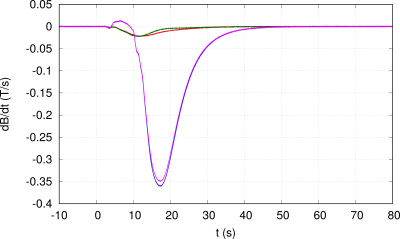 |
3 | Characterization of health and technological risks posed by the quench of a human high-field Magnetic Resonance system
Nicola Pace, Leonardo Ricci, Mario Scotoni, Alessio Perinelli, Jorge Jovicich
The programmed quench of a human 4T MR scanner was used to measure dB/dt inside the bore to evaluate cardiac stimulation risks during a quench. Additionally, we measured the exit temperature of the helium gas, to evaluate potential implications in quench pipe design. The maximum dB/dt was 360 mTs−1 at the center of the magnet, far below the cardiac stimulation threshold (20 Ts−1). Helium exit temperature reached 35°K, perhaps implying further considerations about quench pipe design and building. Replication of similar experiments on programmed quenches, specially in high-field MRI systems, will be useful to further characterize quench risks.
|
|
1437. 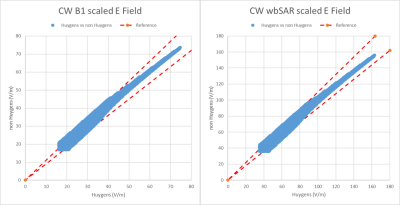 |
4 | Impact of Huygens Box in 3T MRI RF Safety Assessment
Xin Huang, Xi Lin Chen, Shiloh Sison
Huygens Box is an efficient simulation technique to reduce simulation time and storage space. This paper uses simulations to investigate the impact of Huygens box on 3T MRI RF Safety Assessment. The numerical results on ASTM phantom shows the overall Symmetric Mean Absolute Percentage Error (SMAPE) average on typical MRI RF simulation is 6.28%.
|
|
1438. 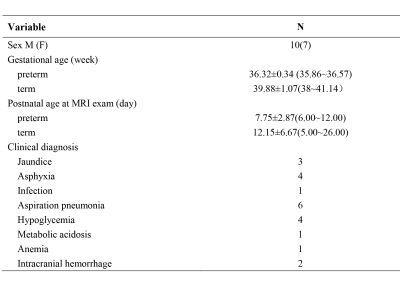 |
5 | A subtle reaction of neonatal cochlear function after exposure to 3.0T MRI noise with hearing protection
Huifang Zhao, Chao Jin, Peiyao Chen, Heng Liu, Xiaoyu Wang, Yannan Cheng, Xingxing Tao, Yuli Zhang, Fan Wu, Cong Tian, Xiaocheng Wei, Jian Yang
Although 3.0T MRI has been increasingly used for neonates, the strong noise remains a great concern. This study aimed to estimate the effect of MRI noise on neonatal cochlear function. Thirty ears of 17 patients with no hearing impairment were enrolled. Distortion product OAE (DPOAE) tests were performed to estimate the cochlear function. Significant increase of mean DPOAE amplitude by 1.13 dB at 3kHz was found within 30 minutes after MRI. Besides, standard deviations of DPOAE amplitude differences remarkably increased. A subtle reaction in cochlear function was found in neonates after exposure to 3.0T MRI noise with hearing protection.
|
|
1439. 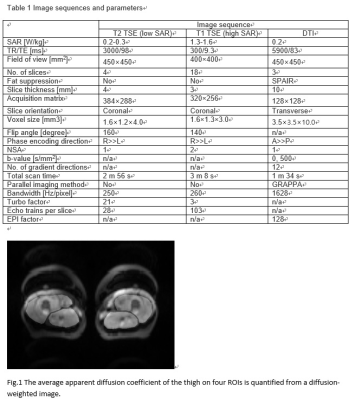 |
6 | Assessment of RF energy-induced temperature elevation in a human thigh in vivo using MR diffusion tensor imaging
Youngseob Seo, Zhiyue Wang
The feasibility of evaluating RF heating-induced temperature elevation in a human thigh in vivo during MRI was demonstrated . RF heating-induced temperature elevation in human thighs can be assessed in vivo during MRI. Reliable knowledge of RF heating allows safe and optimal utilization of MRI techniques. RF heating during MRI could change the observed mean diffusivity value and affects clinical interpretation of the results.
|
|
1440. 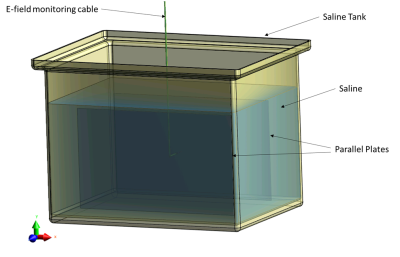 |
7 | A MRI Gradient Induced Electric Field Exposure System for Active Implanted Medical Devices
Xiyao Xin, Xi Lin Chen, Xin Huang, Shiloh Sison
MRI gradient field can produce electric field (E-field) in a patient during MR scan. For patient with active implanted medical device (AIMD), damage and malfunction are the possible outcomes due to such exposure. The ISO/TS 10974 radiated immunity test method in Clause 16 focuses on producing radiated gradient field (dB/dt) exposure. This abstract proposes a test method which directly exposes AIMD to gradient frequency E-field, offering a controlled gradient frequency E-field exposure environment for AIMD MR conditional testing.
|
|
1441.  |
8 | Uncertainty Analysis of Torque Measurement Methods Described in ASTM F2213-17
Xiao Fan Ding, William Handler, Blaine Chronik
With the prevalence of medical implants and MRI both on the rise around the world; patients, device manufacturers, and medical professionals alike should know how implants interact with the MR environment. One such interaction is the possibility of torque on an implant due to interaction with the main field. The current methods for measuring induced torque are published by ASTM International. However, although methods are available, their accuracy and precision have yet to be properly studied. This abstract investigates the measurement uncertainties of the two methods for measuring magnetically induced torque published in the test standard, ASTM F2213-17.
|
|
| 1442. |
9 | Neurological and Neuropsychological Status of Patients with Numerous Applications of Gadolinium-Based Contrast Agents. Follow up of 14-16 Years
Josef Vymazal, Lenka Kramska, Hana Brozova, Aaron Rulseh
Gadolinium deposition in the brain following gadolinium-based contrast agents (GBCA) application has become an important safety concern, however investigations into the effect of gadolinium deposition remain limited. We performed neurological and neuropsychological evaluation in four patients that received very high cumulative doses of linear and macrocyclic GBCAs (mean 728.25 ml, range 562–915 ml) over a range of 14–16 years. Although increased T1 signal was observed in the globus pallidus and dentate nuclei of all patients, the neurological status did not change. No signs of extrapyramidal symptomatology were detected, nor did neuropsychological testing reveal any relevant impairment implicating involvement.
|
|
1443. 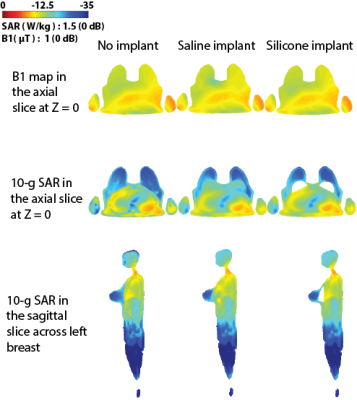 |
10 | An Initial Simulation Study of Breast Implants for Clinical Breast MRI
Xin Li, Xin Chen, Michael Steckner, Joseph Rispoli
Breast augmentation continues to be the #1 cosmetic surgery for women, with approximately 4% of the US female adult population receiving an implant. Additionally, implants are commonly employed for breast reconstruction following mastectomy. Estimating from MR procedure statistics, the breast may be in the imaging volume for up to 10% of all US MRI procedures. This abstract investigates the implications of breast implants (silicone or saline composition with a wide range of conductive properties) on patient safety and suggests there are minimal effects on local (10-g average) SAR and B1 fields.
|
|
1444. 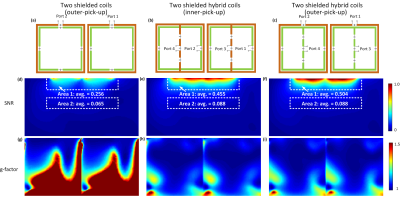 |
11 | Shielded hybrid coil array
Ming Lu, John Gore, Xinqiang Yan
Two major factors that limit the performance of Rx coil arrays are restrictions on coil geometry and numbers. For the widely used L/C loop array, each loops’ size has to be reduced to achieve an increased number of coils. An alternative approach is to use hybrid coils which combine loops with other resonator shapes such as a figure-of-8 coil, butterfly coil, microstrip or dipole. However, the coupling between elements in hybrid coil arrays proves to be challenging due to the proximity of more coil elements. To solve this problem, we propose a novel design named “shielded hybrid coil” which combines hybrid loop+figure-of-8 resonators with circumferential shielding. We proposed two kinds of shielded hybrid resonator arrays (inner- or outer-pick-up) that exhibit an obvious Rx-performance improvement compared to conventional loop arrays. We also find that the Rx-performance is better with outer-pick-up.
|
|
1445. 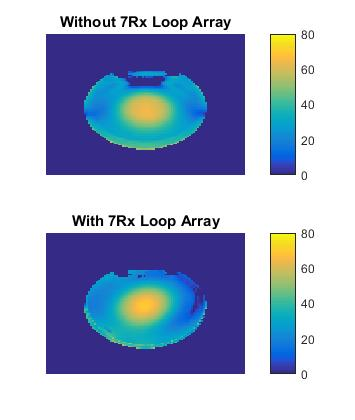 |
12 | A 15-Channel Loop Dipole Array for In Vivo Swine Head MR Imaging at 10.5T
Nader Tavaf, Russell Lagore, Sean Moen, Adrienne Watson, Michael Garwood , Dee Koski , Alex Coutts , Kamil Ugurbil, Gregor Adriany, Pierre-Francois Van de Moortele
Novel RF coil designs must address ultra high field MRI challenges and simultaneously exploit benefits thereof in terms of higher signal-to-noise ratio and reduced acquisition time. A 15-channel RF array was built composed of a 7-channel loop receive array and an 8-channel dipole transceiver array with the receive array designed to be scalable to high density arrays. Transmit B1 maps demonstrated transmit field immunity to receive array insertion. The absolute SNR generated by the loop array receiver is on average 2.65 times the absolute SNR of the dipole transceiver in locations near the receiver array. The coil was successfully used in combination with dipole transceivers to acquire in-vivo swine brain anatomical images at 10.5T.
|
|
1446. 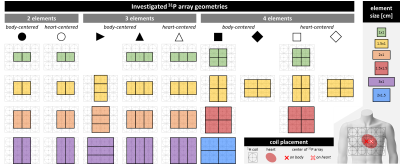 |
13 | Simulation comparison of 28 different 31P arrays for cardiac MR spectroscopy at 7 T
Sigrun Goluch-Roat, Martin Vit, Albrecht Schmid, Elmar Laistler
31P-MR spectroscopy measures cardiac energetics in vivo directly by means of ATP and PCr, but is limited due to low SNR due to the low MR sensitivity of the 31P nucleus and limitation by the achievable B1+. Comprehensive RF coil design considerations and planning help fully exploit the SNR gain by increase of B0. In this simulation study we compare 28 different 31P 7T RF coil array designs with respect to their transmit field performance and obtain a 3-channel array as the best variant.
|
|
1447.  |
14 | An electronically tunable X-nuclei surface coil with high impedance broadband LNA
Andreas Horneff, Michael Eder, Erich Hell, Johannes Ulrici, Benedikt Schlecker, Jens Anders, Volker Rasche
In this approach, we present an electronically tunable surface coil in combination with a high impedance broadband LNA for X-nuclei MRI experiments with a bandwidth between 34MHz and 104MHz. The performance of the approach was evaluated by comparison with a state of the art LNA / surface coil reference setup for hydrogen and fluorine imaging. The resulting SNR reduction was less than 4% and a mean value and standard deviation of the relative error of the sensitivity map between the reference setup and the proposed setup of µ=0.4% and σ=1.4% was observed.
|
|
1448.  |
15 | Design of large-size, high-frequency, loop-type surface coil using dipole antennas for ultrahigh filed MR imaging: a feasibility study at 400MHz and 600MHz
Shasha Yue, Xiaoliang Zhang
Due to the parasitic capacitance and increased inductance, building large-size high frequency RF coils, including surface coils for human MR imaging applications at ultrahigh fields, is a challenge. By taking the advantage of high frequency capability and large size of dipole antennas, in this work, we propose a novel surface coil design method using the proposed V-shaped dipole antennas for large-size, high-frequency, loop-type surface coils in ultrahigh field MR applications in humans. The results show that the proposed large size loop-type dipole surface coils (~20cm or ~16cm diameter) have the potential to generate common B1 field distributions of traditional loop-type surface coils at 9.4T (400MHz) and 14T (600MHz). This opens up the possibility of constructing high frequency large size surface coils for ultrahigh field MR imaging in humans.
|
|
1449. 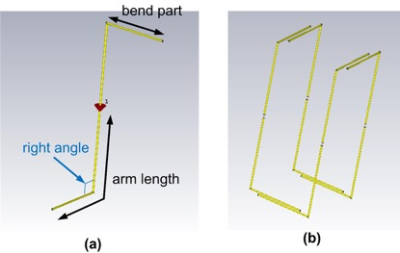 |
16 | A new non-array volume coil structure using the right-angled-end dipole antenna for ultrahigh field MR
Shasha Yue, Luo Chao, Zhe Wang, Yan Hou, Ye Li, Xiaoliang Zhang
Previous work demonstrated that it is feasible to design non-array volume coils using the coupled dipole antennas. However, the weak coupling of the standard dipoles and over-length make the design difficult and also limit its utility. In this work, we propose a modified dipole structure which can be used for high frequency non-array volume coils with improved coupling. It also provides certain flexibility in coil length control. Results of the proposed design at 400 MHz and 500MHz (i.e. 9.4T and 11.7T) are presented.
|
|
1450.  |
17 | Calibrated Coil Combination for Fixed-Geometry, Low-Frequency Coils with Application to Hyperpolarized 13C Measurements
Juan Diego Sánchez Heredia, Rie B. Hansen, Rafael Baron, Esben S. Szocska Hansen, Daniel H. Johansen, Vitaliy Zhurbenko, Christoffer Laustsen, Lars G. Hanson, Jan H. Ardenkjær-Larsen
We explore a new design approach for low frequency RF coils, where a transmit and receive array are built together in a totally rigid frame, and therefore their B1+ and B1-distributions can be accurately mapped and used as prior information for SNR-optimal combination of signals from different coil elements. Using this principle, a coil is designed for 13C MRS of a pig at 3T (32.13 MHz). We show that at this frequency, the effect of sample loading is minimal, and the prior information obtained in phantoms benefits in-vivo experiments. This one-time calibration allows for optimal combination of coil signals, which is also expected to improve parallel imaging performance.
|
|
1451. 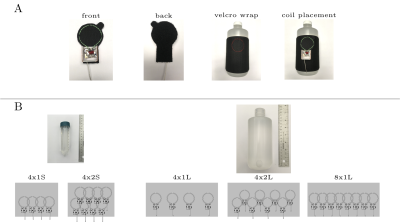 |
18 | A modular 7T high-impedance array for ex-vivo imaging
Shin-Ichi Urayama, Bei Zhang, Koji Fujimoto, Tomohisa Okada, Martijn Cloos
The high SNR provided by whole body 7T also provides enticing opportunities for ex-vivo imaging. However, such MRI systems are usually only equipped with a limited number of coils, rarely optimized for ex-vivo imaging. In this work, we leverage the new-found degrees of freedom provided by High Impedance Coil elements to create a versatile modular array-coil that can be re-configured in seconds to fit each sample optimally.
|
|
1452. 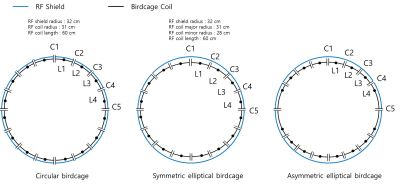 |
19 | Optimization of 4-Port Asymmetric Elliptical Birdcage RF Coil for 1.5 Tesla MRI
Suchit Kumar, Jeong-Hee Kim, Heung-Kyu Lee, Chang-Hyun Oh
The elliptical whole-body radiofrequency (RF) coil can be used for RF transmission/reception in magnetic resonance (MR)-guided treatment or MR-fused system with space between the RF shield and the gradient coil available for other imaging/treatment modality. The elliptical birdcage has higher B1+ field uniformity than circular birdcage due to increased filling factor between the RF coil and target. In this work, the asymmetric elliptical birdcage is proposed to improve overall performance through electromagnetic simulations. This work compares the 2-port and 4-port excitations and their effects on B1+ field uniformity and SAR deposition for both circular and elliptical coil with symmetrical/asymmetrical structures.
|
|
1453. 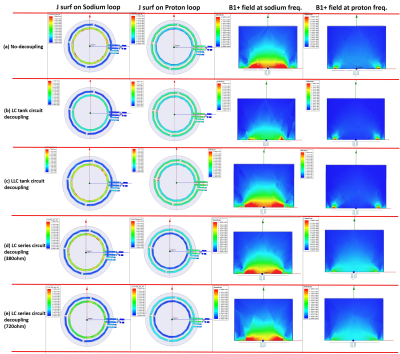 |
20 | Decoupling circuit design for multi-nuclear RF coil
Seunghoon Ha, Adam Morris, Jay Berres, Jonathan Nass
The demand about invivo multi-nuclear MRI/MRS has increased according to introduction of higher tesla MR system. The development of the dual frequencies RF coil array keeps pace with this interest. At the overlay of both the proton and second-nucleus frequencies coil loops, inductive coupling between coils has resolved to retain proton sensitivity and coil tuning stability by LLC and LC tank circuit. However, they cause another mutual coupling issue between the circuits and coil loops. Therefore, we introduce a simpler and more efficient decoupling method than LLC and LC tank circuit in this study.
|
|
1454. 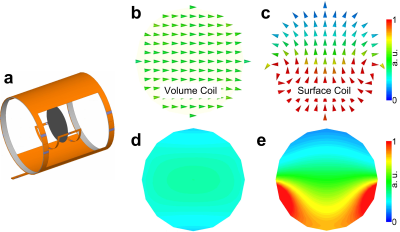 |
21 | Combined volume T/R and surface Rx-only coils for simultaneous brain and spinal cord imaging of squirrel monkey at 9.4 T
Xinqiang Yan, Feng Wang, Ken Wilkens, Daniel Colvin, Li Min Chen, John Gore
Simultaneous imaging of
|
|
1455 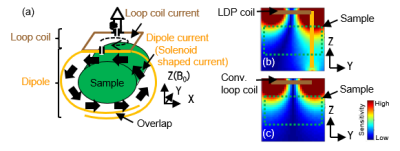 |
22 | Loop Array RF Coil for Vertical Field MRI using Loop/Dipole Parallel RF Coils Video Permission Withheld
Yosuke Otake, Kohjiro Iwasawa, Hisaaki Ochi, Masayoshi Dohata, Takahide Shimoda
To increase the SNR of an RF array coil for vertical field MRI, a loop/dipole parallel RF (LDP) coil was developed. The SNR was increased by forming a solenoid shaped current on an array coil using the LDP coils. The performance of the coils was evaluated using an electromagnetic simulator. The SNR of the LDP coil was 9% better than that of a conventional loop array coil. This technique will contribute to increasing the SNR of the array coil for vertical field MRI.
|
|
1456. 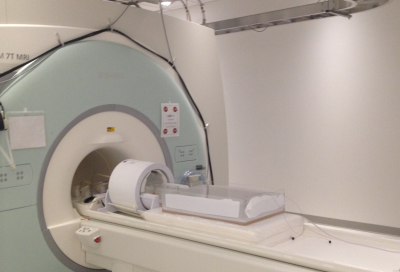 |
23 | RF-induced heating pattern of a partially immersed conducting implant wire at 7T – its dependence on wire length
Pallab Bhattacharyya, Bhumi Bhusal, Tanvir Baig, Mark Lowe, Michael Martens, Stephen Jones
Radiofrequency induced heating at 7T of an insulated wire (exposed at tip) partially immersed in ASTM gel phantom to evaluate safety of scanning partially implanted guidewires, implants like stereo electroencephalography (SEEG) electrodes at different configurations, and conducting wires at that field strength. A transmit-receive coil was used for this study. Heating at certain resonance lengths separated by half a wavelength in air was observed. The heating at resonance lengths were 3-4 times less than that reported earlier at 3T at same specific absorption rate, and under similar configurations and settings.
|
|
1457. 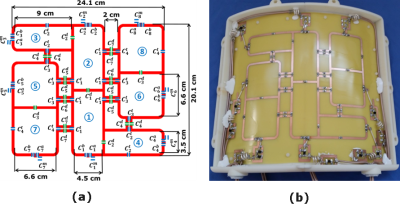 |
24 | Development of Asymmetric 8Tx/16Rx Coil Array for Human Cardiac MRI at 7 T: RF Shimming and SAR Safety Study
Ibrahim Elabyad, M. Terekhov, M. Stefanescu, M. Fischer, L. Schreiber
A novel transceiver 8Tx/16Rx coil array was simulated and developed for cardiac magnetic resonance imaging (cMRI) in humans at 7T. The developed cardiac coil array consists of two independent parts, the semi-curved anterior array and the flat posterior array, each array composed of identical 8-elements. An optimization routine has been developed in MATLAB to find the optimal phases for B1+-field homogeneity with minimal local SAR values within the Duke and Ella human models. RF-shimming improves the B1+-field homogeneity by 30% and 46% for Duke and Ella, respectively. The novel cardiac pTx array has higher Tx-efficiency and flexibility in RF-shimming compared to the 1Tx commercial coil.
|
|
 |
1458. 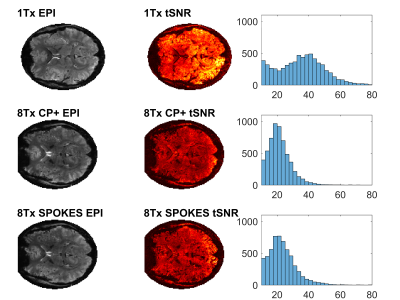 |
25 | Initial experience with SPOKES EPI on a 7T Terra scanner
Belinda Ding, Iulius Dragonu, Catarina Rua, Christopher Rodgers
This abstract describes our initial experiences using the parallel transmit (pTx) mode on our recently-installed 7T Terra MRI scanner (Siemens, Germany). We acquired data from a phantom and a human volunteer with a turbo-FLASH B1-mapping sequence and an EPI sequence. We used the conventional single-channel system with a Nova 32-channel 1Tx head coil and the pTx system with a Nova 32-channel 8Tx head coil. For the parallel-transmit system, the sequences were run in both a static CP+ B1 shim mode, and with dynamic online SPOKES-2 pulse design. We report temporal signal-to-noise ratio (tSNR) statistics for each image series.
|
Digital Poster
| Exhibition Hall | 09:15 - 10:15 |
| Computer # | |||
1459. 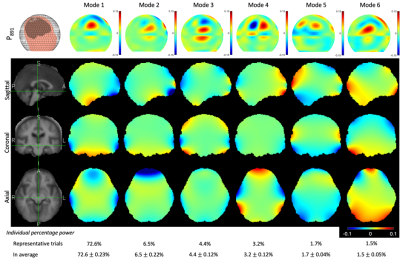 |
26 | Numerical assessment of a multi-coil shimming system in human brain MRI
Pei-Yan Li, Yi-Tien Li, Fa-Hsuan Lin
We numerically evaluated the performance of multi-coil shimming in human brain using an array of up to 1,000 coils with realistic off-resonance distributions of 37 healthy participants. The average and variation of shim current distributions were revealed. Singular Value Decomposition suggested orthogonal current modes to reduce off-resonance. The first 6 current modes accounted for about 90% of the variance of shim current distributions. They achieved shimming performance comparable to the 5th-order and 4th-order spherical harmonic in global and slice-selective shimming, respectively.
|
|
1460. 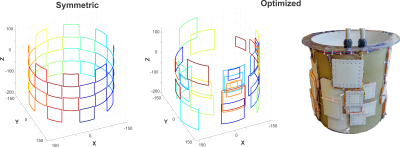 |
27 | A 32-channel multi-coil shim setup optimized for the human brain, pushing the limits of shimming at 9.4T
Ali Aghaeifar, Jiazheng Zhou, Irena Zivkovic, Joshi Walzog, Mirsat Memaj, Theodor Steffen, Rahel Heule, Feng Jia, Maxim Zaitsev, Klaus Scheffler
Multi-coil shimming is an effective approach to reduce B0 field inhomogeneity. In this work, we optimized a 32-channel multi-coil to fit best for shimming of the human brain. The individual coils are optimized in terms of size and position. The performance is compared with the conventional symmetric design.
|
|
1461. 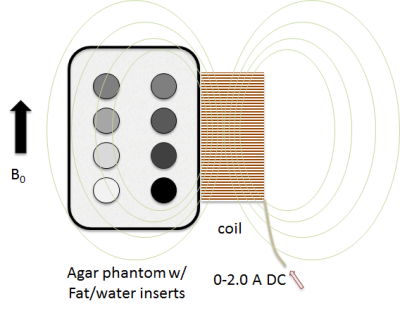 |
28 | An adjustable susceptibility phantom for evaluation of field mapping and fat fraction estimation algorithms
Paul Picot, Junmin Liu, Maria Drangova
We demonstrate a method to produce phantoms with arbitrary and easily adjustable susceptibility distributions. Objects in a magnet bore cause high order inhomogeneities not correctable by shimming, and confound magnetic field mapping and phase unwrapping algorithms. We show a wire winding carrying direct current can simulate an object of adjustable susceptibility, for rapid testing of field mapping and phase unwrapping methods.
|
|
1462. 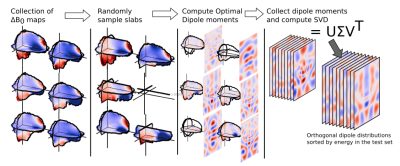 |
29 | Ultimate B0 Shim and the Design of Optimal Shim Bases
Nicolas Arango, Jason Stockmann, Elfar Adalsteinsson, Jacob White
Simulations providing an upper bound on ?B0 shimming of 1096 human brains from the human connectome project with currents outside the target volume were performed and used to construct optimal n-channel shim fields. Optimal truncated shim basis performance was evaluated suggesting 70 optimal channels are required to achieve 95% of ultimate performance. Comparisons with arrays of regularly spaced circular loops suggests that under realistic current constraints, regular loop arrays with hundreds of elements only achieve 85% of ultimate performance. The ultimate ?B 0 shim and optimal n-channel coils will be useful tools in the analysis and comparison of shim array designs.
|
|
1463. 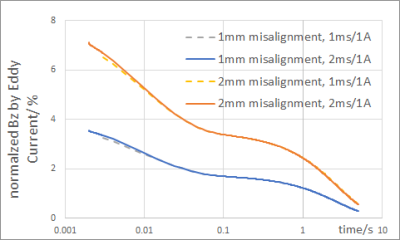 |
30 | Analysis of B0 Eddy Current in Superconducting MRI System Involving Main Coil Circuit
Yihe Hua, Teck Beng Yeo, Thomas Foo
The B0 eddy current, which shifts the temporal B0 and is harmful to MR Image quality, hasn’t been analyzed in detail before. In this work, we provide a FEM-circuit co-simulation method for this problem and the result clearly shows that main superconducting coil plays an important role in shaping the B0 EC time constant and thus to include them in model is necessary for making accurate prediction.
|
|
1464. 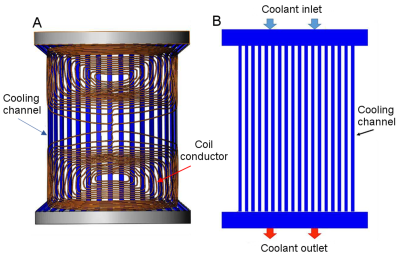 |
31 | A short gradient coil with “outer-wall direct cooling" for human brain imaging Presentation Not Submitted
Hanbing Lu, Zhi Yang, Beihan Zhao, Yong Pei, Bao Yang
Optimal gradient performance is arguably a pre-requisite to realize the full potential of ultrahigh field MRI. The values of using tailored gradient coils for brain imaging have been well acknowledged. Unfortunately, conventional head-only gradient coils have two major technical limitations, i.e. limited shoulder clearance and limited cooling capacity. A new design, coined “auto-rim” gradient coil, combined with a novel cooling method, named “outer-wall direct cooling”, is proposed to fundamentally solve these two technical problems. As a proof-of-concept, we have built a protype gradient coil capable of generating 20.2, 13.5 and 29.1 Gauss/cm/600 ampere current along X, Y and Z, respectively.
|
|
1465. 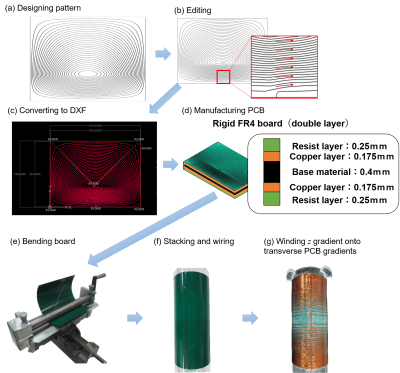 |
32 | Low-cost gradients using commercially-available printed circuit boards
Junpei Matsuzaki, Tomoyuki Haishi, Yasuhiko Terada
Gradient coils often need expensive, manufacturing processes such as gluing, etching, and/or milling. The purpose of this study is to propose low-cost gradients using commercially-available printed circuit boards (PCBs). For proof of concept, we fabricated four types of PCB-gradients for different MRI systems: cylindrical transverse gradients for a 1.5 T, 280 mm-bore superconducting magnet (SCM), for a 4.7 T, 89 mm-bore SCM, and for a 9.4 T, 54 mm-bore SCM, and planar gradients for a 0.2 T, 160 mm-gap permanent magnet. We verified that the PCB gradients outperform the hand-wound gradients.
|
|
1466.  |
33 | Numerically optimized design for a low-cost, lightweight 86mT whole-brain magnet
Patrick McDaniel, Clarissa Cooley, Jason Stockmann, Lawrence Wald
Whole-brain imaging is a major use of MRI, but the cost and siting requirements of scanners limit its use. Here, we propose a close-fitting, lightweight, whole-brain MRI system to address these limitations. We design the B0 magnet for this system using a novel optimization approach and compute simulated B0 maps using 3 magnet modeling approaches. In doing so, we demonstrate the feasibility of realizing an acceptably-uniform whole-brain MRI magnet with mean B0 of 86mT and weighing under 25kg.
|
|
1467. 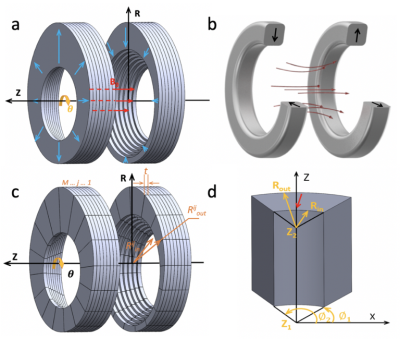 |
34 | An Irregular Aubert Ring-Pair-Aggregate Optimized with Improved Gradient for Head Imaging in a Low-field Portable MRI System
Zhi Hua Ren, Jia Gong, Shao Ying Huang
We present a design and optimization of an irregular Aubert ring-pair-aggregate permanent magnet array that generates 2D B0-field with an improved gradient for head imaging for a low-field portable MRI system. The ring-aggregates are discretized into fan-shaped sections with identical angles and varying outer diameters for design and optimization. Genetic algorithm (GA) was used. Compared to a Halbach-array, the proposed array shows an increased in field strength (111.2 mT) with a controlled inhomogeneity, and an enhanced gradient (off-center-concentric-pattern). It leads to better reconstructed images using simulations where the central blurring area is eliminated.
|
|
1469. 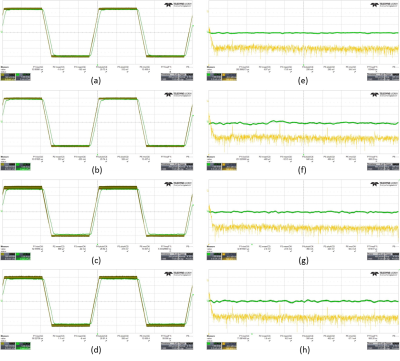 |
35 | Single H-Bridge Shimming Driver
Huijun Yu, Sebastian Littin, Feng Jia, Stefan Kroboth, Maxim Zaitsev
The multi-channel shimming coils have been proposed to improve the magnetic field homogeneity locally. The one-coil-one-driver solution is preferred to keep the high flexibility. The linear-mode and switch-mode solutions are feasible for such low current applications. However, the switch-mode current driver has the advantage of smaller size in space-limited situations, such as for coils with high number elements. Here we present the design and implementation of a single H-bridge shimming driver. The performance comparison of analog controller and digital controller is shown, and also two different pulse width modulation methods.
|
|
1470. 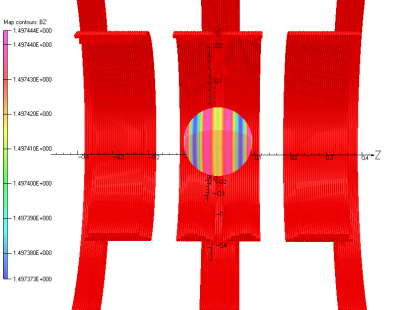 |
36 | A cryogen-free actively shielded HTS magnet for a 1.5 T MRI system
Yi Li, Steffen Lother, Andreas Voß, Robert Odenbach, Leander Bartsch, Stefan Röll
A cryogen free actively shielded magnet for 1.5 T MRI is being developed. High temperature superconductor is used for the fabrication of the magnet. We bring this first prototype for neonatal MRI system which requires more compact dimension and tighter stray field of the magnet. Magnet design has been finished and one coil of the total seven coils has been built and tested. The experimental results are satisfactory in terms of cooling performance, joint resistance and magnetic field. It successfully approves the feasibility of the concept and more results will be shown when the conference starts.
|
|
1471. 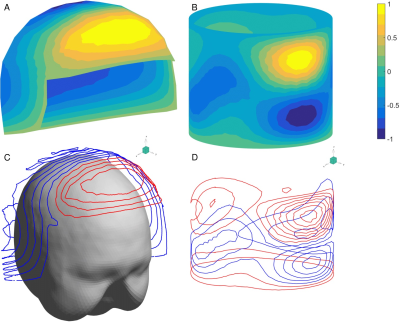 |
37 | Designs of shim coils with distributed currents for 3T human brain magnetic resonance imaging
Mustafa Kaan Çan, Pei-Yan Li, Jiazheng Zhou, Pu-Yeh Wu, Yi-Tien Li, Risto Ilmoniemi, Fa-Hsuan Lin
We propose single-channel head shim coils with either a helmet or a cylinder geometry. Shim current paths were designed by the stream function method with a realistic target field from a group of human subjects (n = 31). A smoothness constraint was included to decrease shim coil complexity. Helmet and cylinder shim coils with shim current amplitudes 4.2 and 6.9 A improved the standard deviation of residual magnetic field by approximately 17%, respectively.
|
|
1472. 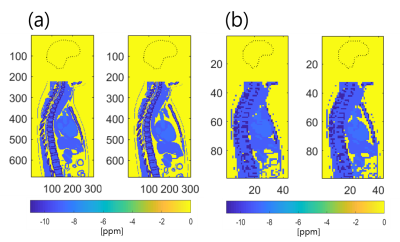 |
38 | High-resolution numerical simulation of respiration-induced dynamic B0 shift in the head in high-field MRI
So-Hee Lee, Ji-Seong Barg, Seok-Jin Yeo, Seung-Kyun Lee
To investigate B0 fluctuation in the head induced by respiration in high field MRI, we simulated respiration with a human 4D phantom model, and calculated B0 in the brain by an efficient calculation algorithm. Simulated B0 was analyzed for the spatiotemporal distribution and voxel size dependence. The amplitude of dynamic B0 change exhibited strong inferior/superior gradient and significant anterior/posterior gradient, consistent with previous experimental data. Compared to the previous modeling studies, our simulation can yield more reliable, high-resolution results within a relatively short calculation time.
|
|
1473. 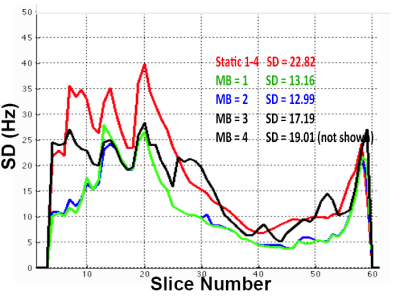 |
39 | Dynamically Updated B0 Shimming for Multi-band Imaging with High Order Spherical Harmonics
Hoby Hetherington, Chan Moon, Jullie Pan
High order spherical harmonic shims (SH) and multi-coil approaches have demonstrated that the best B0 homogeneity for 2D human brain imaging is achieved by dynamic updating and single slice-by-slice (SBS) shimming. However, the use of multi-band (MB) imaging with its superior data collection efficiency has overshadowed the benefits of single SBS updating. In this abstract we demonstrate that MB=2 B0 shimming (MBB0) can be achieved with equivalent homogeneity as single SBS imaging for SH shimming with a 4th+ high order/degree shim insert. For MBB0 =3 or 4, significant gains over static 4th order shimming are predicted.
|
|
1474. 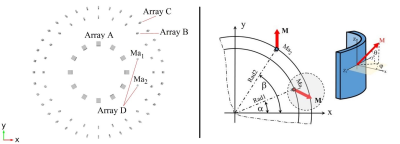 |
40 | Permanent magnet based 3D spatial encoding for Ultra-Low field MRI
Michael Vogel, Ruben Pellicer-Guridi, Jiasheng Su, Viktor Vegh, David Reutens
We explore the use of small permanent magnets moving along prescribed helical paths for spatial encoding in ultra-low field magnetic resonance systems based on Halbach arrays. A semi-analytical simulation method was developed to analyse different magnet path and orientations. For proof-of-concept, different helical magnet paths and lengths for one and two small magnets were considered to establish spatial encoding efficiency. We demonstrate that a single small encoding magnet moving around the sample in a single helical revolution can be used to generate 3D images via the method of back projection for image reconstruction.
|
|
1475. 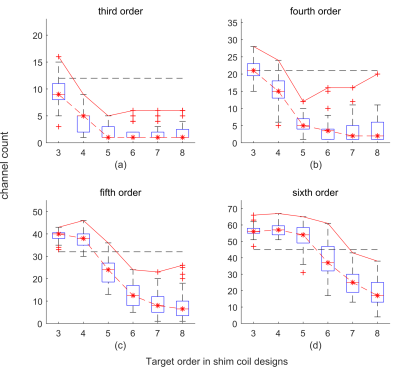 |
41 | Design of a shimming coil matched to the human brain anatomy
Feng Jia, Hatem Elshatlawy, Ali Aghaeifar, Sebastian Littin, Stefan Kroboth, Ying-Hua Chu, Yi-Cheng Hsu, Xiang Gao, Huijun Yu, Philipp Amrein, Wenchao Yang, Jiazheng Zhou, Pierre Levan, Klaus Scheffler, Maxim Zaitsev
We propose a novel design method of a shim coil specially optimized for the human brain. Numerical results demonstrate the validity of the method. The resulting coil layouts can pave a way towards a novel shimming coil specifically intended for human brain shimming. The proposed design method can be extended to other applications and organs.
|
|
1476. 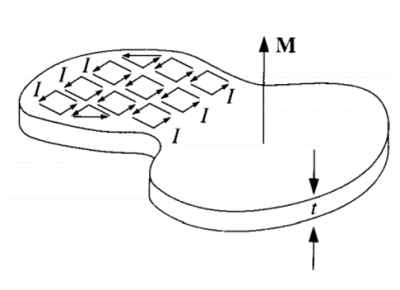 |
42 | The Dipole Boundary Method : a simple approach to compute stream functions for shim coil design
Bruno Pinho Meneses, Alexis Amadon
A simple and easy to implement method for shim coil design is proposed as an alternative to most popular, but complicated methods. It is straightforward in obtaining the optimal stream function, which is further discretized into a coil wiring, using an analogy to magnetized material and a boundary discretization into square dipoles. Simulation results show good performance in designing spherical harmonics shim coils.
|
|
1477. 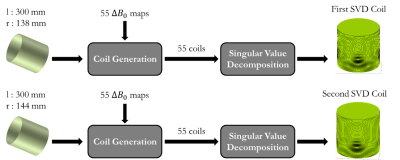 |
43 | Optimized multi-coil array design for human brain shimming at Ultra-High Field
Bruno Pinho Meneses, Michel Luong, Alexis Amadon
A numerical method based on stream function Singular Value Decomposition is proposed for optimization of Multi-Coil array (MCA) design for human brain shimming. It provides geometries other than circles for shim loops and halves the amount of channels needed to achieve the same whole-brain inhomogeneity reduction as current MCA systems. Strong impacts are expected for imaging and spectroscopy at Ultra-High Field.
|
|
1478 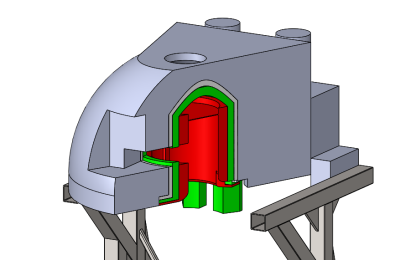 |
44 | Passive shimming for a Portable Head-Only scanner Video Permission Withheld
Mark Hunter, Konstantinos Bouloukakis, Sebastian Theilenberg, Naoharu Kobayashi, Christoph Juchem, Ben Parkinson
Part of a collaboration under NIH grant U01EB025153 is leading to the development of a highly compact brain imaging scanner. In order to realize the required B0uniformity of the scanner, we have developed passive shimming techniques that will be robust despite a low field uniformity and non-cylindrical magnet warm bore layout. This presentation describes the methods and results we will use to shim our compact scanner.
|
|
1479. 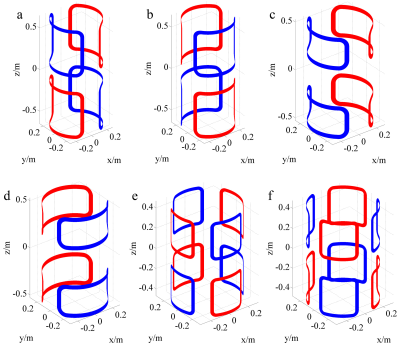 |
45 | Superconducting shim coil design using a quasi-saddle geometry
Yaohui Wang, Qiuliang Wang, Lei Guo, Zhifeng Chen, Zhongbiao Xu, Hongyi Qu, Feng Liu
An improved method was proposed to design superconducting shim coil with smooth rounded corner, which can significantly ease the winding and fabrication, and augment the magnetic field accuracy. A quantitative comparison between the shim coil using the improved strategy and the conventional standard design shows clear advantage.
|
|
1480. 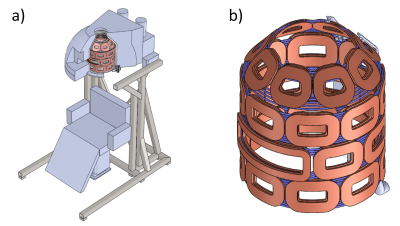 |
46 | Multi-Coil Array for Combined Imaging and B0 Shimming in a Portable Head-Only Scanner
Sebastian Theilenberg, Yun Shang, Naoharu Kobayashi, Ben Parkinson, Christoph Juchem
To improve accessibility of MRI and to enable advanced studies on motor coordination, we are part of the U01EB025153 collaboration to develop a compact 1.5 T head-only scanner enabling free limb movement. The compact size of the magnet significantly increases B0 inhomogeneity, necessitating the use of novel imaging concepts robust to B0 inhomogeneities that in turn require advanced B0 field modeling capabilities. Here, we introduce a 31-coil Multi-Coil (MC) design capable to generate linear and non-linear MR image encoding fields as well as complex B0 shim fields with low space and power requirements.
|
|
1481. 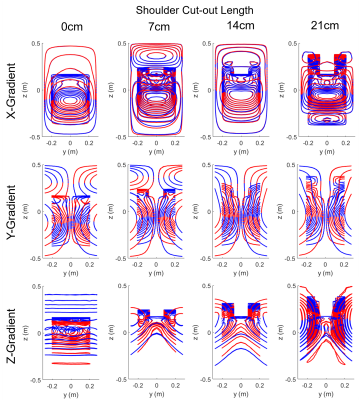 |
47 | Preliminary Design Exploration for a Head and Neck Gradient Coil: Effect of Shoulder Cut-out Length on Performance
Eric Lessard, William Handler, Blaine Chronik
A preliminary design study on a shoulder cut-out head and neck gradient coil for improved imaging of the neck was performed. The designs presented here allow a shifted imaging region such that the neck and cervical spine can be placed directly in the imaging region. This work represents the first step in a larger design study and work is still ongoing to determine the effect on gradient coil performance as design parameters are modified. Ultimately, this will allow high performance imaging of both the head and neck.
|
|
1482. 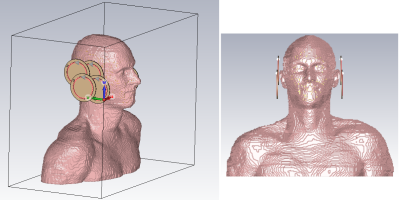 |
48 | Overlapped Monolithic Transmission Line Resonator Receiver and B0 Shim Array For Functional Imaging of the Human Temporal Lobe
Alexander Bratch, Jerahmie Radder, Parker Jenkins, Steve Jungst, Gregory Metzger, Kamil Ugurbil, Gregor Adriany
Transmission Line Resonator (TLR) coils have been employed and evaluated as simultaneous RF Tx/Rx and B0 shimming elements. However, overlapped variants of these designs which target specific brain regions have yet to be attempted. Here, we have developed an overlapped TLR Rx/B0 shimming array targeted for imaging the temporal lobe at 7T. Bench testing and simulation results demonstrate the feasibility and benefits of an overlapped TLR Rx/B0 shimming array for targeted imaging of targeted brain structures.
|
|
1483.  |
49 | A novel few-channel coil design for human brain shimming based on stream function Singular Value Decomposition
Bruno Pinho Meneses, Alexis Amadon
A method for whole-brain shim coil design for Ultra-High field is proposed using Singular Value Decomposition of tailored stream functions to create a small set of independently driven coils providing the same performance as shim inserts with numerous high-order spherical harmonics coils.
|
Digital Poster
| Exhibition Hall | 09:15 - 10:15 |
| Computer # | |||
1484. 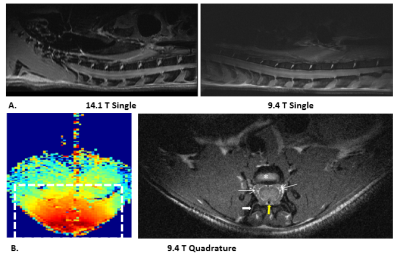 |
51 | Dipole antenna for rat spinal cord imaging at ultra-high field
Ting Yin, Ileana Jelescu, Rolf Gruetter, Özlem Ipek
Dipole antenna designs were introduced to pre-clinical spinal cord imaging at ultra-high field. The tuning and matching circuit can be adapted to both 9.4 T and 14.1 T magnet with simple adjustment. Dipole antennas provided good longitudinal coverage for the animal, and optimal penetration for spinal cord imaging. In terms of transmit efficiency and field homogeneity over rat spinal cord, dipole antenna design is a flexible and promising candidate for ultra-high field imaging.
|
|
1485. 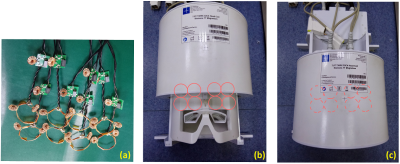 |
52 | Attachable B0-shim Array: An Add-on for RF Coils
Yang Gao, Yi Sun, Xiaotong Zhang
In the present study, as an add-on to commercial-available RF coils, a novel B0-shim coil design for local B0 shimming was proposed, based on which 8-channel B0-shim array has been designed to attach to Nova 1Tx/32Rx head coil for local B0 shimming at 7T. With minor interference to RF coil, the apparent improvement in local B0 shimming has been demonstrated by using the proposed attachable B0-shim array. The present setup offers a feasible and promising means for practical higher-order local B0 shimming technology. It is believed that the proposed approach could potentially merit a broad scope of researches such as clinical diagnosis and cognitive neuroscience.
|
|
1486. 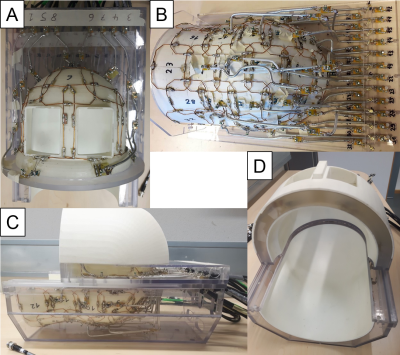 |
53 | A 32-channel transmit/receive radiofrequency head coil for 7T UHF MR
Stefan Rietsch, Stephan Orzada, Sascha Brunheim, Andreas Bitz, Maximilian Voelker, Viktor Pfaffenrot, Marcel Gratz, Daniel Leinweber, Jonathan Weine, Sarah Handtke, Oliver Kraff, Mark Ladd, Peter Koopmans, Harald Quick
In this work, a 32-channel transmit/receive (32Tx32Rx) head coil for 7T UHF MRI was developed and evaluated. The performance of this coil is compared to a commercially available 1Tx32Rx head coil regarding noise correlation, signal-to-noise ratio (SNR) and B1 homogeneity. The results indicate that high flexibility concerning RF shimming is provided by the 32Tx32Rx head coil that translates into a more homogeneous flip angle distribution compared to the 1Tx32Rx head coil. First 7T MR imaging results show the increased coverage of both the head and superior parts of the neck.
|
|
1487. 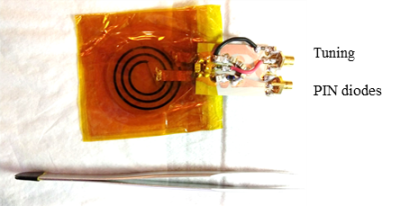 |
54 | High-Q, tunable High Temperature Superconducting receiver coil for 13C applications
Rafael Baron, Juan Sanchez-Heredia, Daniel Johansen, Vitaliy Zhurbenko, Jan Ardenkjær-Larsen
Dissolution DNP has emerged as a technique to improve SNR in an NMR experiment with inherent limitation of polarization retention in solution ranging, in general, from 30 to 100 s for the interesting bio-molecules. The limitation in sensitivity and available time window can be, however, improved by a better SNR of the RF receivers. At 3 T the Larmor frequency of the 13C nuclei is 32.13 MHz, which is still in the electronics noise dominated regime for smaller coils. A High-Temperature Superconducting (HTS) receiver coil with high-Q, remotely tunable, detunable and compatible to standard electronics Tin soldering has been developed for MRI 13C applications.
|
|
1488.  |
55 | MR vessel wall imaging of intracranial and carotid arteries with a 40-channel coil system at 3 T
Qiaoyan Chen, Zidong Wei, Lei Zhang, Changjun Tie, Qiang He, Xiaoliang Zhang, Xin Liu, Hairong Zheng, Ye Li
Due to the small cross-sectional size of the vessel wall and the cord, and susceptibility effects, especially in the carotid and the spinal cord, MR vessel wall imaging of intracranial and carotid arteries still remains challenging. In this work, a 40-channel coil system that consists of a 32-channel head coil combined with an 8-channel carotid coil was implemented and characterized in its performance by comparison with a 24-channel head and neck joint coil. As a result, the proposed 40-channel coil system provides improved performance in SNR, parallel imaging capability, and image quality.
|
|
1489. 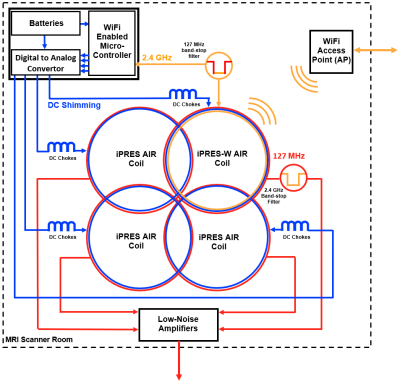 |
56 | A 4-Channel iPRES-W AIR Coil Array for Simultaneous MR image Acquisition and Wirelessly-Controlled Localized B0 Shimming of the Spinal Cord
Jonathan Cuthbertson, Dean Darnell, Robert Stormont, Fraser Robb, Allen Song, Trong-Kha Truong
B0 inhomogeneities near air-tissue interfaces can cause distortions, signal loss, and incomplete fat suppression in many applications such as diffusion-weighted imaging of the spinal cord. Here, we develop a 4-channel iPRES-W AIR coil array to perform simultaneous imaging and wirelessly-controlled localized B0 shimming of the cervical spinal cord. In vivo experiments showed a 58.5% reduction in B0 root-mean-square-error (RMSE) after shimming the spinal cord using the iPRES-W AIR coil array, resulting in substantially reduced geometric distortions in diffusion-weighted images, ADC maps, and FA maps
|
|
1490. 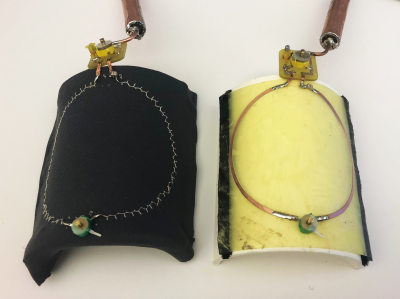 |
57 | Stretchable and Flexible Conductive-Thread Based Radiofrequency Coils for Magnetic Resonance Imaging
Jana Vincent, Joseph Rispoli
An omnidirectional stretchable and flexible radiofrequency coil has been developed using conductive thread stitched onto athletic material. This single-loop surface coil can be placed at the closest proximity to the skin. When compared to a flexible, copper-clad printed circuit board coil, resulting MR FSE images of a muscle phantom showed comparable SNR and image quality, especially when compared to a PCB coil spaced 4.2 cm above the phantom. This design allows not only for close proximity of placement to the skin, but also for joint imaging at various degrees of flexion and positioning.
|
|
1491. 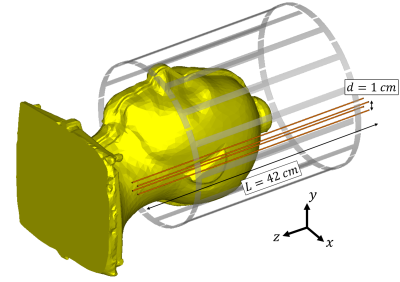 |
58 | Enhancement of transmit and receive efficiencies with hybridized meta-atom in 7T head coil
Marc Dubois, Lisa Leroi, Zo Raolison, Redha Abdeddaim, Tryfon Antonakakis, Julien De Rosny, Alexandre Vignaud, Pierre Sabouroux, Elodie Georget, Benoit Larrat, Gérard Tayeb, Nicolas Bonod, Alexis Amadon, Franck Mauconduit, Cyril Poupon, Denis Le Bihan, Stefan Enoch
We show that hybridized meta-atom can be used to improve transmit and receive operation in a 7T head birdcage coil equipped with a 32-channel receive array. Our results demonstrates the enhancement of both transmit and receive signal with the possibility to fill one of the gap usually observed in the brain temporal lobes. This metamaterial based passive shimming strategy provides a cost effective, long-lasting, and non-toxic solution without any impact on the patient’s comfort during the examination.
|
|
1492. 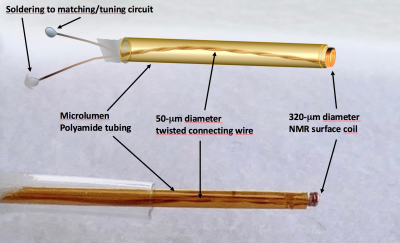 |
59 | Minimally invasive implantable NMR microcoil for in vivo MRS and MRI in submicroliter volumes
Yannick Crémillieux, Noël Pinaud, Benadjem Felouah, Vi Pham, Alan Wong
Due to sensitivity and invasiveness issues, the use of implanted NMR microprobes remains a poorly explored field of research, with no emerging or significant biomedical applications. In this study, we report the realization, characterization and applicaiton of an innovative design for implantable microprobe allowing a drastic minimization of the probe invasiveness. The results obtained in vitro and in vivo demonstrate the potential of this microprobe architecture for MRS and MRI investigation of organs and tissues in submicroliter volumes.
|
|
1493.  |
60 | Universal Coils: Multisubject Optimization of 8-Channel Many-Element Parallel Transmit Arrays
William Grissom, Xinqiang Yan, Zhipeng Cao
A large number of coils is desirable in parallel transmission to achieve uniform excitation while controlling SAR in a subject-adaptive manner, but only a small number of transmit channels are available on most ultra-high field scanners. We describe an algorithm that optimally groups a large number of coils into a small number of channels, based on the fact that if two coils are in the same channel, the matrix formed by collecting their slice-by-slice RF shims will have rank one. The algorithm was used to optimize the coil-to-channel mappings of a 30-coil array at 7T, based on 8 representative heads.
|
|
1494. 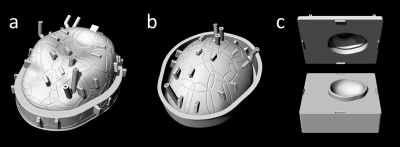 |
61 | A 48-Channel ex vivo Brain Array Coil for Diffusion-Weighted MRI at 3T
Alina Scholz, Markus May, Robin Etzel, Mirsad Mahmutovic, Nicolas Kutscha, Lawrence L Wald, Anastasia Yendiki, Boris Keil
In diffusion weighted MRI in vivo spatial and angular resolution is often limited to the macroscale regime, due to the maximum examination time that is appropriate for human subjects. Ex-vivo DWI of fixed tissue can overcome this limitation by providing large acquisition times. Therefore, a 48-channel ex-vivo brain array receive coil was developed to be used with the 3T Connectome diffusion scanner. The coil was characterized with both bench and image metrics and compared to a 64ch whole head coil. The size-optimized 48-channel array coil provides increased reception sensitivity and is well-suited for high resolution ex-vivo MRI studies.
|
|
1495. 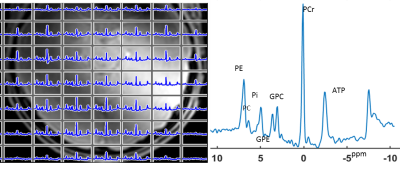 |
62 | Towards uncompromised merging of 1H and 31P receive arrays for multi nuclear metabolic imaging in the brain at 7T
Ines Chavarria, Dimitri Welting, Marco Fantasia, Quincy van Houtum, Jannie Wijnen, Dennis Klomp, Bart Steensma
In order to optimally integrate 31P MRS and 1H MRI, a 1H birdcage coil is combined with a 16 channel dual-tuned 31P/1H receive loop array for 7T, inserted in a 31P
|
|
1496. 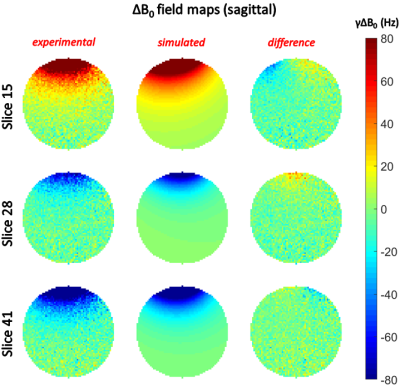 |
63 | Real-time image-based tracking of B0 shim elements in flexible matrix shim arrays for dynamic B0 shimming of the abdomen
Bernhard Gruber, Jason Stockmann, Bastien Guerin, Lawrence Wald
High-order matrix shimming has proved useful for addressing B0 susceptibility issues but requires prior knowledge of the shim elements position. For rigid coil formers the shim loops are fixed in space and the field maps can be pre-measured in a phantom. Flexible or movable arrays used in abdominal imaging present a challenge since the element position is patient-specific. Here we introduce a marker system for rapidly detecting the element position prior to or during matrix shimming. Our tests show we can successful determine loop position to accurately generate B0 field maps in good agreement with experimentally measured maps.
|
|
1497. 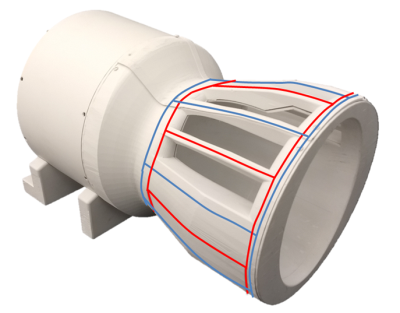 |
64 | A PET COMPATIBLE 17O/1H COIL FOR SIMULTANEOUS MULTINUCLEAR PET/MR
Karthik Lakshmanan, Seena Dehkharghani, Guillaume Madelin, Ryan Brown
Direct MR oximetry by imaging 17O isotope can be a viable alternative over the conventionally used 15O PET tracer. In this work we developed a dual-tuned 17O/1H coil array with potential PET compatibility to explore brain oximetry and support simultaneous PET tracers to provide complementary insights into brain function.
|
|
1498. 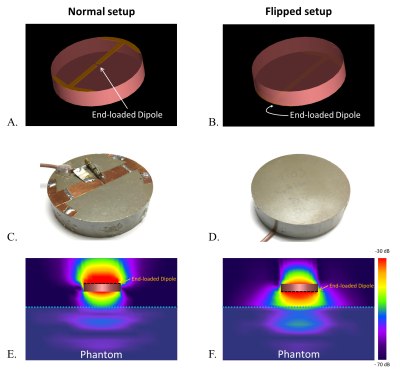 |
65 | Improved B1+ efficiency of a dipole antenna equipped with high dielectric constant (HDC) materials at 10.5T
Myung Kyun Woo, Lance DelaBarre, Russell Lagore, Steve Jungst, Qing Yang, Bei Zhang, Sebastian Rupprecht, Riccardo Lattanzi, Mike Lanagan, Maryam Sarkarat, Kamil Ugurbil, Gregor Adriany
We evaluated the performance of 10.5T RF coils composed of dipole antennas and high dielectric constant (HDC) ceramic materials placed in close proximity to the dipole antenna. We investigated the impact of the location of the HDC material relative to the dipole antenna. Both simulations and experimental verification indicate that a counterintuitive “Flipped” geometry positioning the dipole between the HDC material and the sample shows notable improvement in terms of the B1+ efficiency. We suggest further exploration of this new setup for ultra-high field (UHF) transmit arrays.
|
|
1499 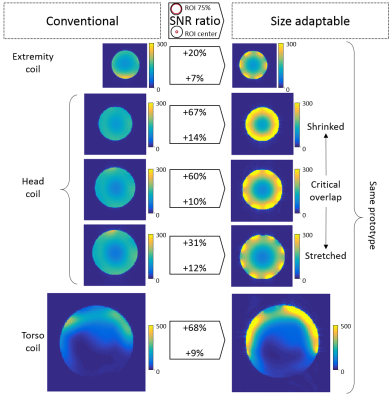 |
66 | Prototype investigation for a size adaptable RF receiver coil capable of various body parts and sizes Video Permission Withheld
Kohjiro Iwasawa, Yosuke Otake, Hideta Habara, Kazuyuki Kato, Hisaaki Ochi
A size-adaptable RF receiver coil prototype which can displace inter-element distance with negligible SNR degradation was investigated. We applied a simple method to enhance blocking impedance of the preamp decoupling circuit by using intentionally small matching capacitance. SNR of the size-adaptable prototype was evaluated for phantoms of 5 sizes ranging from knee size to abdomen size against commercial coils dedicated for each body parts. Despite of its broad size adaptability across various body parts and sizes, the prototype showed higher SNR than each commercial coil.
|
|
1500. 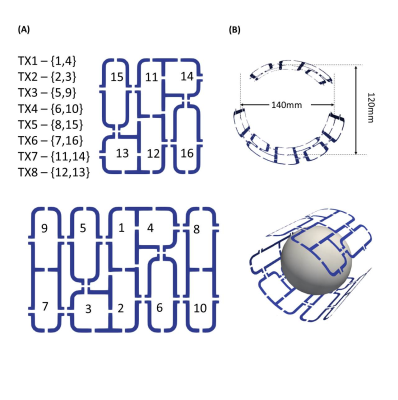 |
67 | Development and Test of an Optimized 8TX/16RX Array for Ultra-High Resolution Ex-Vivo Myocardial Tissue Characterization with 7T MRI : Initial Experience and Quality Assessment.
Maxim Terekhov, Ibrahim A. Elabyad, David Lohr, Maria R. Stefanescu, Laura Schreiber
The MRI measurements of the excised hearts providing stable “ground truth” high resolution images are important part of cardiac MRI at ultra-high field. We report the initial results of testing an in-house developed multiple element transceiver array (mTA) with parallel transmit support optimized for submillimeter spatial resolution ex-vivo heart tissue characterization MRI at 7T. The array testing included SNR, B1-shimming, g-factor, T2* and DTI mapping with high parallel imaging acceleration factors. The designed 8TX/16RX array demonstrated high efficiency of both TX and RX properties for (ultra)high ex-vivo myocardial tissue characterization imaging at 7T with essential superiority to a commercial 1TX/32RX coil.
|
|
1501. 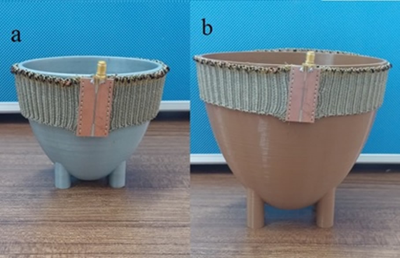 |
68 | WEARABLE AND STRETCHABLE SURFACE BREAST COIL
Busra Kahraman Agir, Basak Bayrambas, Korkut Yegin, Esin Ozturk Isik
A novel wearable and stretchable single loop breast coil made from conductive thread is introduced with a coil geometry which can expand and retract in accordance with the breast while preserving good quality factor. Images of both the small phantom and the medium phantom could be acquired by S-M coil. Similarly, M-L breast coil was used to obtain the images of both the medium phantom and the large phantom. Highest SNR was obtained when small phantom was imaged using S-M coil and the lowest SNR was obtained with large phantom when it was imaged using M-L coil.
|
|
1502. 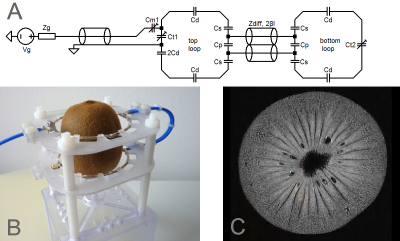 |
69 | Application of an RF Current Mirror for MRI Transmit Coils
Roland Müller, Tobias Lenich, Evgeniya Kirilina, Harald Möller
Some types of MRI transmit coils (e.g. Helmholtz coils) require equal currents in different coil elements. We present a novel feeding concept based on a passive RF current mirror, which ensures equal currents even if the loading and tuning of individual elements differ. Analytical equations are given for the dimensioning. It is demonstrated by simulations and experiments that the concept is viable, especially for ultra-high field imaging.
|
|
1503. 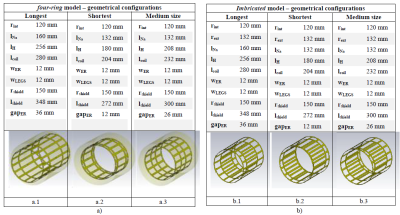 |
70 | 1H-23Na Dual-Tuned Radio-Frequency volume coil design for MRI at 7 T
Francesca Maggiorelli, Alessandra Retico, Eddy Boskamp, Fraser Robb, Angelo Galante, Marco Fantasia, Marcello Alecci, Gianluigi Tiberi, Michela Tosetti
We present a systematic comparison between two dual-tuned (DT) RF coil models through electromagnetic simulations. The first model (imbricated) consists of two concentrically placed birdcages, whereas the second model (four-rings) consists of two High-Pass birdcage-like structures nested over an internal Low-Pass birdcage. For both DT-RF coil models, the dimensional parameters have been varied in order to optimize the B1+ field homogeneity and the coil efficiency at the proton (298.03MHz) and sodium (78.86MHz) Larmor frequency at 7T. Results show that the longest four-rings DT-RF coil model has the best performances.
|
|
1504. 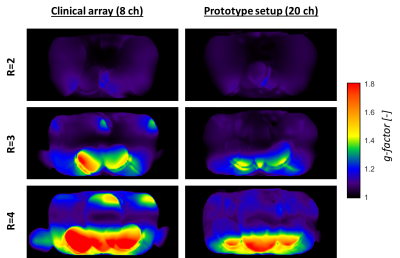 |
71 | A radiolucent and flexible high impedance coil array to improve the imaging performance of a 1.5T MR-linac
Stefan Zijlema, Luca van Dijk, Jan Lagendijk, Rob Tijssen, Cornelis van den Berg
High impedance coils (HICs) are interesting for use in dense receive arrays for the MR-linac, as they lack lumped elements that attenuate radiation. Furthermore, HICs are flexible and exhibit low channel coupling, simplifying high-density array development.
We compared the performance of a 20-channel prototype setup with the current clinical array and investigated its dosimetric feasibility. The prototype showed higher SNR values and lower g-factors, thus allowing for higher acceleration factors and faster imaging. Dosimetrically, no clinically significant attenuation was found (<1.5%). In conclusion, flexible HIC based arrays are highly suitable to construct high density arrays for MRI-guided radiotherapy applications. |
|
1505.  |
72 | Design and Evaluation of a Novel 8Tx/16Rx Symmetric Coil Array for Cardiac MRI in Large Animals (Pigs) at 7T: Investigation of Decoupling Using a Common Central Ring
Ibrahim Elabyad, M. Terekhov, M. Stefanescu, D. Lohr, M. Fischer, L. Schreiber
A dedicated 8Tx/16Rx coil array was designed and tested for cardiac magnetic resonance imaging (cMRI) ex-vivo pigs at 7T. The cardiac array is composed of 16-elements with physically independent anterior and posterior parts. The anterior array is composed of 8-elements and resembles a symmetric circular shape coil. The central four-elements are decoupled using a common central ring and shared decoupling capacitors. The posterior array was built using 4×2 rectangular symmetric elements configuration. Ex-vivo high-resolution cardiac images were acquired with 0.3 mm x 0.3 mm in plane resolution. The dedicated coil enhances the SNR within the heart by about four-times compared to a commercial human coil.
|
|
1506. 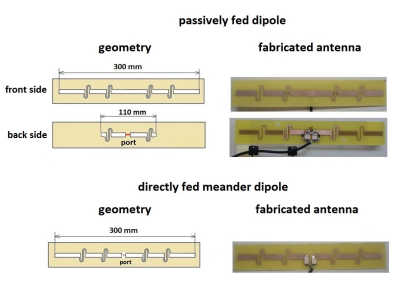 |
73 | A low SAR eight element passively fed meander dipole array for 7T prostate imaging
Irena Zivkovic, Catalina Arteaga de Castro, Andrew Webb
The purpose is to compare the performance of an eight element passively fed meander dipole antenna designed for body MRI at 7 Tesla with that of a conventional actively fed array. The measured mean transmit efficiency (B1+/square root input power) in the prostate was 15% lower with the passively fed dipoles array, but the simulated max SAR10g was 44% lower, meaning that the overall SAR efficiency of the passively fed array is higher. In vivo RF shimmed turbo spin echo images showed similar image quality for both arrays, but with lower SAR values for the passively fed array. |
|
1507. 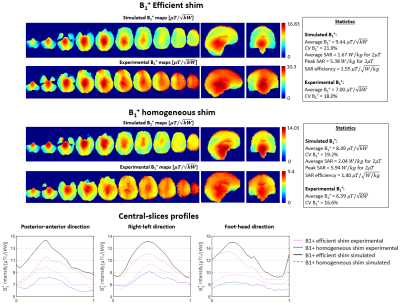 |
74 | Optimization of RF system for homogenous, consistent, and safe neuro imaging at 7T MRI
Tales Santini, Sossena Wood, Tiago Martins, Nadim Farhat, Salem Alkhateeb, Howard Aizenstein, Tamer Ibrahim
This work presents two shimming cases for homogenous B1+ at 7T. The Tic-Tac-Toe system was optimized using FDTD simulations and experimentally verified. In the homogenous shim case, the array was capable of delivering a homogeneity of 16.6% (measured) with a SAR efficiency of 1.40μT/√(W/kg) (simulated). In the B1+ efficient shim case, a measured homogeneity of 18.0% and SAR efficiency of 1.55μT/√(W/kg) (simulated) was obtained. The B1+ field was measured over the whole head above and including the cerebellum and excluding the nasal cavities. The coil performance was compared with the TEM coil and experimentally verified with TSE and T2-SPACE sequences.
|
|
1508. 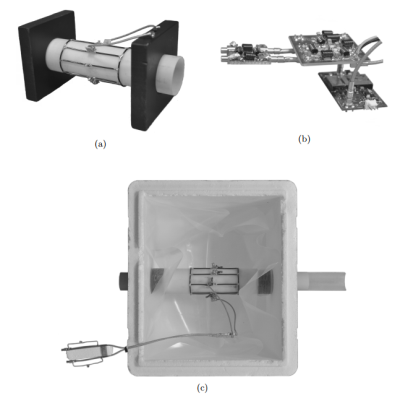 |
75 | On the SNR of Cryogenic Receive Coils when using Room Temperature Preamplifiers
Daniel Højrup Johansen, Juan Diego Sanchez-Heredia, Vitaliy Zhurbenko, Jan Henrik Ardenkjær-Larsen
Significant increase of the signal-to-noise ratio (SNR) is possible by cooling receive coils to cryogenic temperatures, if they are not highly sample noise dominated. Conventionally, the noise of the preamplifier is excluded leading to an overestimation of the achievable SNR gain. In this work, we show that for the case of a small-animal birdcage coil for 13C at 3T cooled with liquid nitrogen to 77K, the SNR is overestimated by approximately 40% if the effect of the room temperature preamplifier is excluded. Hence, the preamplifier should either be included in the SNR gain estimation or cooled with the coil.
|
Digital Poster
| Exhibition Hall | 09:15 - 10:15 |
| Computer # | |||
1509. 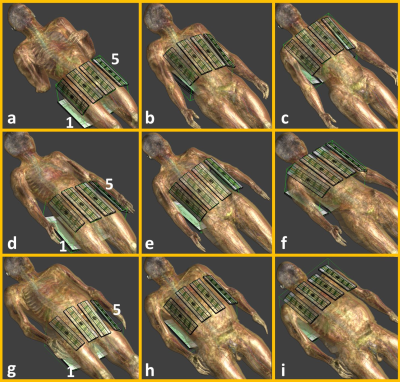 |
76 | Evaluating 8-independent channel shimming strategies to drive a 16-channel loop-dipole transceiver body imaging array at 7.0 Tesla
M. Arcan Erturk, Gregory Metzger
Majority of the installed 7.0T systems have 8-independent transmit channels, therefore additional hardware changes are necessary to fully utilize higher channel count transceiver arrays (i.e. 16-channel loop-dipole body imaging array, 16LD). Here, we investigated three different 8-independent channel phase shimming strategies to drive 16LD and compared against fully independent 16-channel phase-only shimming. 8-independent channel shimming while transmitting power from all 16 array-elements with pre-determined phase difference between loop and dipole elements on the same block causes only about 10% drop in B1+ efficiency compared to 16-independent channel transmit.
|
|
1510. 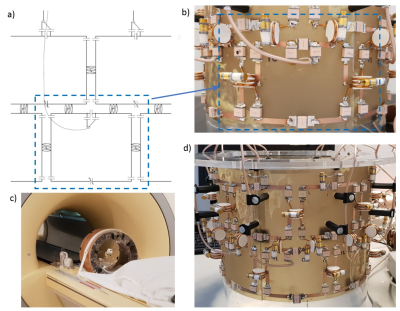 |
77 | Development of a 16 channel rotated double row transceiver array for neuroimaging at 7T
Nick de Jong, Wyger Brink, Thomas Ruytenberg, Thomas O'Reilly, Andrew Webb
A 16 channel rotated double row transceiver array for imaging the human brain at 7T was designed using the recently developed induced current elimination decoupling method. The transmit and receive performance of the coil was characterized by in vivo measurements and compared to a commonly-used commercial two-channel transmit coil.
|
|
1511. 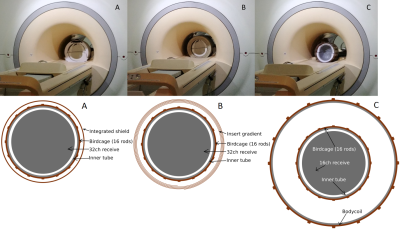 |
78 | B1 performance when excluding RF shields from transmit head coils to simplify multi nuclei and gradient insert setups
D. Welting, I. Chavarria Marques, M. Fantasia, Q. van Houtum, B.R. Steensma, E. Versteeg, J.P. Wijnen, D.W.J. Klomp
RF shielding in MRI is used to enhance B1 efficiency of RF coils by reducing radiation losses and prevent coupling to surrounding materials like the gradient coil (1). However, RF shielding can also complicate the design of RF coils, particularly when used in multi-model setups, like for multi-nuclei experiments or when combined with gradient inserts. Here we demonstrate that the closely fitted RF shield of a head-coil can be removed to use the RF shield inside the bore liner of the MRI system in order to maintain high B1 efficiency.
|
|
1512  |
79 | A multi-function digital receiver for real-time data correction in MRI Video Permission Withheld
Limin Li, Alice Wyrwicz
We report the early development of an integrated receiver built on a Field Programmable Gate Array (FPGA). The receiver offers the functionalities of combining data acquisition, field sensing, real-time data correction and image reconstruction. We describe the design and implementation of the receiver and demonstrate its capabilities of image acquisition and reconstruction with real-time data correction.
|
|
1513.  |
80 | A head transmit-receive array for a high performance gradient insert
Manuela Rösler, Christoph Leussler, David Brunner, Thomas Schmid, Markus Weiger, Franciszek Hennel, Roger Luechinger, Klaas Pruessmann
Achievable gradient performance scales with decreasing gradient size which awakes interest in tight-fitting gradient coil design and requires space-restricted RF solutions. In this work, an eight-channel transmit-receive array coil for human head with a B1 field distribution preventing aliasing from the unambiguity volume of a high performance gradient insert and assuring a low eddy current capability is presented. In this configuration, acceptable homogeneous excitation and parallel imaging can be performed even despite the limited space for RF components.
|
|
1514. 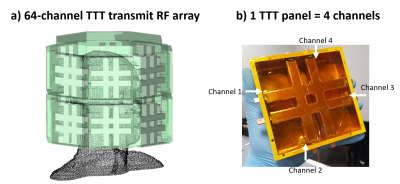 |
81 | Homogenous 64-channel RF transmit array for brain imaging at 7T, 9.4T, and 10.5T
Tales Santini, Sossena Wood, Howard Aizenstein, Tamer Ibrahim
In this work, a 64-channel Tic-Tac-Toe (TTT) transmits array is simulated (with a realistic tuning and matching method) for three field strengths. Phase-only RF shimming was performed to access the array performance. In the whole brain excluding the cerebellum, the coefficient of variation (CV)=15.6%/20.9%/25.0%, Max/Min=3.17/6.29/5.84, for an average B1+=7.47/5.34/3.78μT/√kW at 7T/9.4T/10.5T field strengths, respectively. With these shimming cases, the array presented an average SAR=1.67/2.56/2.72 W/kg for 2μT and SAR efficiency=1.55/1.25/1.21μT/√(W/kg) at 7T/9.4T/10.5T, respectively. The peak SAR=5.35/9.49/10.76W/kg for 2μT at 7T/9.4T/10.5T, respectively. The 64-channel TTT array is capable of producing homogenous B1+ and low levels of SAR for UHF human MRI.
|
|
1515. 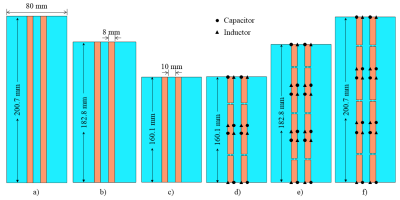 |
82 | Comparisons for microstrip and CRLH transmission lines array coils at 7T
Daniel Hernandez, Jeung-Hoon Seo, Kyoung-Nam Kim
The use of Composite right/left handed (CRLH) metamaterial based transmission lines (TL) for high frequency applications can improve the magnetic field intensity and uniformity. This can be achieved independent from its physical length, contrary to the traditional microstrip TL. In this work we compare the |B1| and |E|-field of the CRLH TL with a common microstrip TL when used in an array of two elements. Three arrays with different lengths were compared, resulting in better field uniformity for the case of the CRLH TL.
|
|
1516. 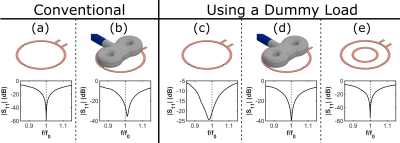 |
83 | Flexible Low-Profile Coil Array Using “Dummy Loads” for Concurrent TMS-fMRI
William Mathieu, Reza Farivar
A system was designed for concurrent TMS-fMRI, where functional images across the entire brain may be acquired while stimulating areas with TMS. Dummy loads were used to counteract the loading effects of the TMS coil. This system was able to perform functional acquisitions on phantoms and biological media with the TMS coil present.
|
|
1517  |
84 | Opencage Radiofrequency Coil Inspired by Metamaterials Video Permission Withheld
Anton NIKULIN, Julien de Rosny, Benoit Larrat, Kylian Haliot, Abdelwaheb Ourir
We propose a volume radiofrequency coil for MRI that provides a lateral access to its inner volume. This coil, called «opencage», is designed by revisiting birdcage coils as metamaterial transmission line with broken periodicity. An opencage dedicated for imaging at 7T of the head of small rodents is developed. The design of this opencage is optimized using numerical simulation. Finally in-vivo preclinical imaging of the head of a mouse is presented. We show that the opencage coil efficiency is similar, especially in terms of field homogeneity and SNR as a conventional 8-legs birdcage coil.
|
|
1518. 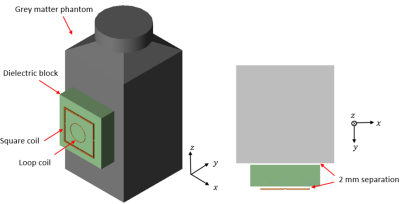 |
85 | Dependence of Radiofrequency field enhancement on the geometry of the monolithic high dielectric ceramics at 3 T
Jue Hou, Sebastian Rupprecht, Christopher Sica, Qing Yang
Ultra-high dielectric constant (
|
|
1519. 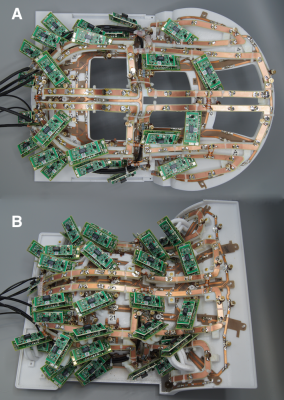 |
86 | Design Considerations of a 64-Channel Receive / 16-Channel Transmit Coil Array for Head, Neck, and Cervical-Spine Imaging at 7 T
Markus May, Robin Etzel, Laleh Golestanirad, Christina Triantafyllou, Yulin Chang, Shivraman Giri, Lawrence Wald, Boris Keil
A 64chRx/16chTx head-neck-Cspine array coil was constructed and bench tested. A new UHF topology has been introduced, by merging two commonly separated array coil functionalities (Rx, Tx) at ultra-high field MRI into one anatomically shaped close-fitting housing. The ultimate two-folded goal of this study was to increase clinical benefit in ultra-high field neuroimaging through the extension of the brain region to the cervical spine and to decrease patient’s anxiety and discomfort using a patient-friendly coil design.
|
|
1520. 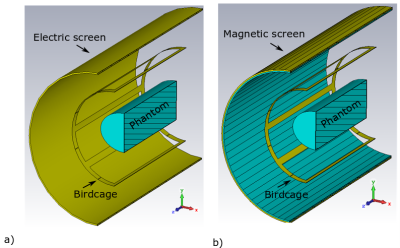 |
87 | A Preclinical Volume Coil with Artificial Magnetic Shield for 7 Tesla MRI
Ksenia Lezhennikova, Anna Hurshkainen, Constantin Simovski, Alexander Raaijmakers, Irina Melchakova, Redha Abdeddaim, Stanislav Glybovski
In this work the artificial magnetic shield structure was proposed aimed to improve the performance of preclinical volume coil for 7 Tesla MRI. Particularly, transmit efficiency as well as receive sensitivity of small-animal bird-cage coil was studied in the presence of both ideal electric and magnetic screen at the first step. Next, practical artificial magnetic shield structure using the principles of operation of high-impedance corrugated surfaces was suggested. B1+ distribution of the small-animal bird-cage coil equipped with corrugated surface structure was calculated and compared with the reference case of ideal electric screen. Numerical results demonstrated improved transmit efficiency and receive sensitivity of the bird-cage coil with the artificial magnetic shield structure comparing to the reference case.
|
|
1521.  |
88 | Common Mode Analysis and SNR Performance of a Traditional Loop Coil versus an Integrated Balun Coil
Wolfgang Loew, Christopher Ireland, Ronald Pratt, Randy Giaquinto, Charles Dumoulin
Common mode field distributions along a coaxial cable attached to a traditional loop coil and an integrated balun coil were analyzed using electromagnetic simulations. For comparison, an equivalent loop and an integrated balun coil were constructed and common mode voltages were measured along the coaxial cable attached to each coil. SNR performance of both coils was measured and analyzed in a phantom at 3T.
|
|
1522. 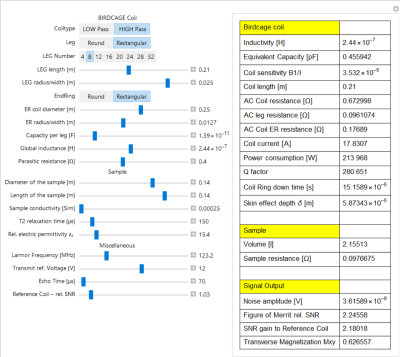 |
89 | Multiparameter Analysis Method for B1 Acquisition (MAMBA): A tool for RF coil design and SNR estimation for short T2* samples
Agazi Tesfai, Johannes Fischer, Ali Oezen, Ute Ludwig, Michael Bock
A software tool (Multiparameter Analysis Method for B1 Acquisition - MAMBA) to design volume coils is presented for short T2* samples that optimizes relative SNR. MAMBA includes relevant RF coil parameters and evaluates performance. Sample and pulse sequence properties such as T2* relaxation times and echo time (TE) are considered. The tool is tested in a comparison of a commercial head coil and an optimized birdcage coil for imaging of an Egyptian mummy head.
|
|
1523. 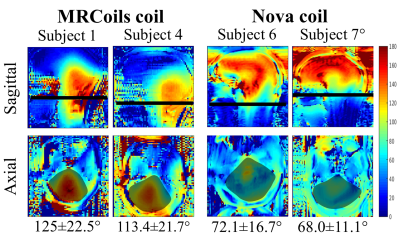 |
90 | Improving RF efficiency in the brain and the neck at 7T using a novel pTx coil
Mohamed Tachrount, Bleddyn Woodward, Emre Kopanoglu, Michel Italiaander, Denis Klomp, Ian Driver, Richard Wise
MRI at UHF is promising for a variety of clinical applications however it is challenging because of B0 and B1 inhomogeneities and SAR limitations. To improve the RF efficiency in the brain and the neck, a novel 8Tx/32Rx RF coil has been built by MR coils. Its performance in terms of B1+ intensity and homogeneity at the brainstem/cerebellum and the neck was assessed and compared with the standard Nova Medical 8Tx/32Rx coil. The novel coil allows for a higher B1+ at the brainstem/cerebellum and the neck where B1+ mapping and shimming need further optimisation for ASL application.
|
|
1524. 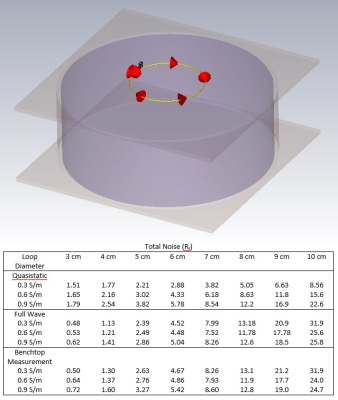 |
91 | Full Wave vs Quasistatic Simulation Accuracy at 3 Tesla
Michael Beck, Dennis Parker, Rock Hadley
Full wave simulations are known for their high accuracy, but simulation optimization is not feasible with FDTD and FEM for vast numbers of MRI coil applications. Optimization strategies do have feasible runtimes for quasi-static solutions, but the system being simulated must be small compared to the electromagnetic wavelength since they do not account for boundary conditions. This work uses multiple single loop coils of different diameters and three phantoms with a simple geometry to compare the accuracy and usefulness of full wave and quasi-static solutions of RF coils at 3T. Full wave simulations proved to be significantly more accurate.
|
|
1525.  |
92 | A 64-Channel Phased-Array Head Neck Coil for Neurovascular/fMRI at 3T
Haoqin Zhu, Xiaoyu Yang, Michael Wyban, Yiping Guan, Yoshinori Hamamura, Yuji Takano, Kazuya Okamoto
Close-fitting the coil elements along the head and neck is a typical design of higher density phased-array head neck coils in order to provide higher SNR and acceleration. But this limits patient comfort and excludes larger patients. In this work we present a 64-channel head neck coil which can image large patients for neurovascular/fMRI at 3T. The coil test results show superior SNR in imaging compared to both a clinical 32-channel head array coil and 16-channel head neck array coil respectively.
|
|
1526. 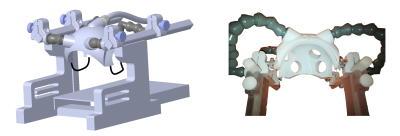 |
93 | A 16-Channel Array Coil for Anesthetized Monkey Multi-modal Neuroimaging at 3T
Yang Gao, Xiaojie Wang, Robert Friedman, Mykyta Chernov, Christopher Kroenke, Anna Roe, Xiaotong Zhang
A 16-channel array coil has been developed in our laboratory for anesthetized monkey brain imaging at 3T, with a specialized design to accommodate multi-modal devices. Its performance has been evaluated on an anesthetized macaque. Compared to the commercially-available pediatric coil, the 16-channel monkey head coil showed improved receive sensitivity and superior acceleration performance. Further, the presented coil can accommodate multi-modal devices, allowing simultaneous optical imaging, neural recording, and stimulation, during high-field MRI studies. It is hoped that the proposed array coil could benefit a broad scope of research in frontier neuroscience.
|
|
1527. 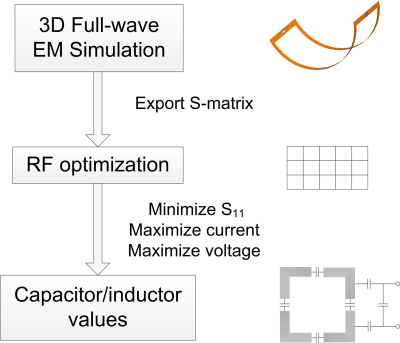 |
94 | Optimization of small animal RF coil with co-simulation approach
Xinqiang Yan, Feng Wang, John Gore
The 3D electromagnetic and RF circuit co-simulation approach is a fast and accurate tool to calculate the EM fields of RF coils. It is typically used for human coils to evaluate the transmit field and SAR. In this work, we apply this method to the circuit optimization of a small animal coil. Unlike human coils, the coil noise of small animal coil is not neglectable and should be minimized. With the guide of co-simulation approach, an optimized saddle-shaped surface coil has considerable transmit efficiency and SNR improvement on ex-vivo squirrel monkey brain imaging at 9.4T.
|
|
1528. 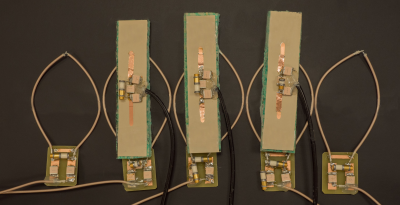 |
95 | A transceive array with passively fed dipoles and shielded loop coils for laryngeal imaging at 7T
Thomas Ruytenberg, Andrew Webb, Irena Zivkovic
A transceive array for laryngeal imaging at 7T was constructed, consisting of 5 shielded loop coils and 3 passively fed dipoles. The array is physically flexible due to the absence of lumped elements in the loops and shows very high inter-element isolation (greater than -19 dB) without implementing decoupling circuits, even though the elements are closely packed. After RF shimming using the array, high resolution turbo spin-echo images were acquired from a healthy volunteer.
|
|
1529. 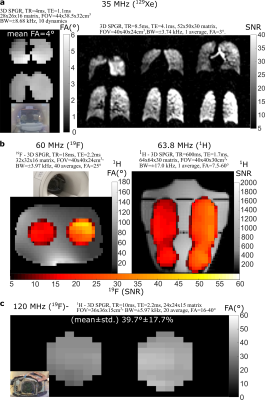 |
96 | Triple Tuned 6-element Asymmetric Mode Ladder-Resonator/Transceive-Array for Thoracic Imaging of 19F/1H at 1.5T and 129Xe/19F at 3T
Adam Maunder, Graham Norquay, Oliver Rodgers, Fraser Robb, Madhwesha Rao, Jim Wild
A 6-element triple-tuned asymmetric mode ladder-resonator/transceive-array was constructed in order to allow direct field strength comparisons of 19F/1H imaging at 3T and 1.5T using the same coil geometry, and to compare 129Xe and 19F imaging at 3T. The designed array is the first instance of triple-tuning a coil by replacing tuning capacitors with LC networks to provide the equivalent reactance needed for coil tuning at three Larmor frequencies (35MHz, 60MHz and 120MHz). Details on construction and simulation are provided and phantom imaging performed for 19F/1H at 1.5T and 19F at 3T, as well as in-vivo imaging of hyperpolarized 129Xe at 3T, demonstrate the functionality of the coil.
|
|
1530.  |
97 | Comparative design study of a 3T 1H RF breast coil: Quadrature vs. Solenoid Design
Sören Bieling, Mark Ladd, Arthur Magill
In this work a comparative design study for the development of a new proton (1H) transmit/receive radio frequency (RF) coil for unilateral breast imaging at 3 Tesla (123MHz) is performed. The two most common RF breast coil designs, based on quadrature and solenoid coils, are compared against each other in terms of spatial homogeneity and first-order statistics (mean µ, standard deviation σ, spread σ/µ) of the circularly polarized RF excitation field (B1+) as well as B1+ scaled over the square root of the maximum 10g-averaged specific absorption rate (B1+/√(SARpeak)).
|
|
1531. 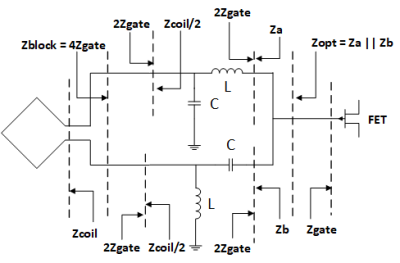 |
98 | Investigation of an artificial line p LC BALUN as a single-stage impedance transformation network, for direct preamplifier and coil matching in MRI surface array coils. Presentation Not Submitted
Miheer Mayekar, Tejkiran Patil, Tapas Bhuiya, Rajesh Harsh
Previous studies have shown that the coil matching network (CMN) and preamplifier input matching network (IMN) can be combined to match the coil loop to the transistor in the preamplifier directly. Through simulations we have shown that the artificial line ‘π’ LC BALUN can be used to match the coil loop to the transistor in the preamplifier directly. Though ‘L’ section LC BALUN is widely used in surface array coils to create high blocking impedance across coils, it has several limitations. Hence, artificial line LC BALUN can be used as impedance transformation network and as a common-mode choke simultaneously.
|
|
1532. 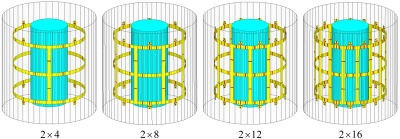 |
99 | Design of multi-row multi-channel degenerate birdcage array coil based on minimum total reflection for the single-channel and circularly polarized modes of excitation
Ehsan Kazemivalipour, Alireza Sadeghi-Tarakameh, Umut Gundogdu, Ergin Atalar
We propose that a transmit coil can be optimized for certain modes of operation. It is well-known that when the number of channels of a degenerate birdcage coil increases coupling between channels becomes a significant problem. The high total reflection when only one of its channels is used as a transmitter caused a small portion of the power delivered to the body. However, when it is properly designed, in some modes of operations such as circularly-polarized mode, the total reflection become negligibly small. In this work, we demonstrate this effect on various two-row degenerate birdcage-coils together with simulations and experiments.
|
|
1533. 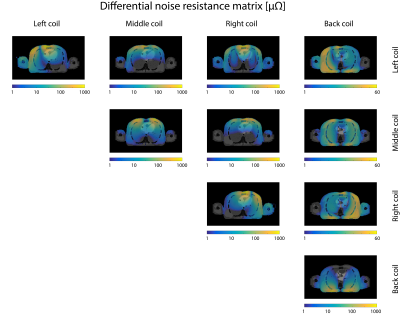 |
100 | Understanding the physical origins behind the noise navigator
Robin Navest, Stefano Mandija, Anna Andreychenko, Jan Lagendijk, Cornelis van den Berg
Thermal noise is ever-present in any MR experiment and can be used for motion detection. To investigate the physical origins behind the noise navigator, electromagnetic simulations were performed on a realistically moving human model. Tissue displacement affects the thermal noise distribution more than dielectric lung property alterations and the difference between 15 and 20 cm coil size is negligible. The differential noise matrix obtained from electromagnetic simulations is a good means to gain understanding on the spatial sensitivity to motion in particular body regions. This understanding can be used to guide optimization and develop new applications (e.g. motion tracking) of the noise navigator.
|
Digital Poster
| Exhibition Hall | 09:15 - 10:15 |
| Computer # | |||
1534. 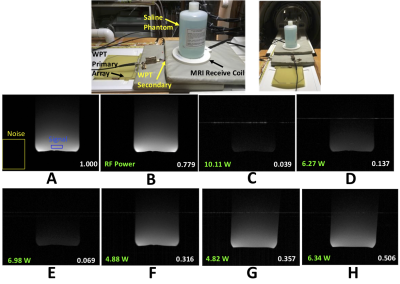 |
101 | Wireless Power Transfer Compatibility and Noise Issues in MRI
Kelly Byron, Fraser Robb, Shreyas Vasanawala, John Pauly, Greig Scott
To achieve completely wireless coil arrays, several watts of power will need to be delivered with minimal impact on the MR images. Wireless power transfer (WPT) has been previously developed to efficiently transfer power, however, harmonics are generated and low frequency noise can be up-converted by both the DC-to-RF conversion and the RF-to-DC rectification of the WPT system. Efficiency can be traded off to reduce noise through additional filtering and rectifier choice, and by replacing the switching supply to the power amplifier with batteries an ultimate SNR performance within 6dB of the ideal can be achieved while continuously transferring power.
|
|
1535. 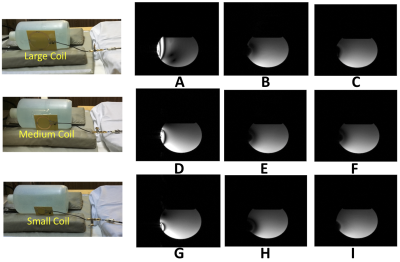 |
102 | Harvesting Power Wirelessly from MRI Scanners
Kelly Byron, Fraser Robb, Shreyas Vasanawala, John Pauly, Greig Scott
As the number of devices accompanying patients inside the MRI bore increases, so does the need for reliable powering inside the MRI. The high-power B1 field in MRI suggests the capability to harvest power wirelessly from the scanner itself. With high quality factor coils and a high efficiency class-E rectifier we are able to harvest 100s of µJ /TR. However, B1 harvesting will generate flip angle banding when harvesting loops are near imaging regions. These banding artifacts increase with increasing coil size and decrease with larger coil loading.
|
|
1536. 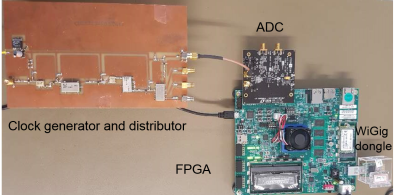 |
103 | Universal WiGig MRI receiver platform with auto-synchronised clock module and ZYNQ-based high-speed digitizer
Yunkyoung Ko, Wenwei Bi, Jörg Felder, N. Shah
The operation of 60GHz data transmission inside the MR room using the WiGig standard has been demonstrated in a previous study. It offers an off-the-shelf solution for reliable, high-speed data transmission as required by modern high-channel-count array coils. However, wireless data transmission is only one component of a complete receiver chain in MRI. Since the ARM-based platform employed in our previous study is not powerful enough to implement full high-speed high-fidelity acquisitions, we propose to connect the WiGig data link with a FPGA board, clock generator board and a high-precision ADC board to increase the speed and the fidelity.
|
|
1537.  |
104 | Wireless Digital Data Transfer based on WiGig/IEEE 802.11ad with Self-Shielded Antenna Gain Enhancement for MRI
Yunkyoung Ko, Wenwei Bi, Jörg Felder, N. Shah
Here we investigate the feasibility of using existing high data rate wireless transmission protocols - a wireless gigabit (WiGig) - suitable for transmitting data from high channel count array antennas. Moreover, the study aims to use off-the-shelf commercial components that, with only minor modifications, allow for maximum flexibility of the implementation. The system presented here overcomes these shortcomings by increasing the antenna gain and provides a practical solution for the wireless transmission of receive signals.
|
|
1538. 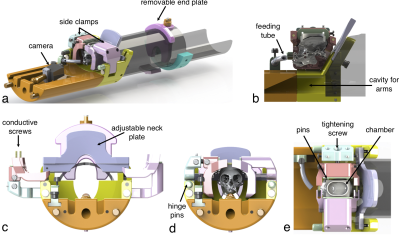 |
105 | Restraint system with integrated receive array for minimizing head motion during awake marmoset imaging
Kyle Gilbert, David Schaeffer, Stefan Everling, Ravi Menon
Marmoset monkeys are an increasingly popular animal model for functional MRI studies due to their close homology with humans. To negate the confounds of anesthesia on brain activation, marmosets can be imaged awake. A restraint chair with an integrated receive array is described for minimizing motion during awake imaging. Motion was limited to 129 μm and 0.41°, allowing for comparable temporal SNR with respect to anesthetized imaging.
|
|
1539 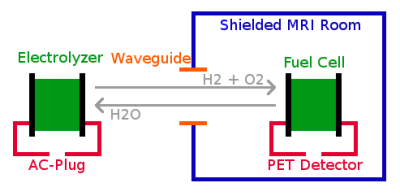 |
106 | About the MRI compatibility of fuel cells as the power source for PET detectors Video Permission Withheld
Nicolas Gross-Weege, Thomas Dey, Bjoern Weissler, Teresa Nolte, Johannes Ramler, Martin Müller, Detlef Stolten, Volkmar Schulz
Since MRI is very sensitive regarding electromagnetic disturbances, the integration of a Positron Emission Tomography (PET) detector into in an MRI system is a sophisticated task. The power supply and cabling of the PET detectors are the main sources of electromagnetic interferences with the MRI. Therefore, we propose to power the PET detectors with a proton-exchange membrane fuel cell (PEMFC). To prove the feasibility of the concept, we evaluated the MRI compatibility of the PEMFC. The PEMFC was able to power PET detectors and only a minor influence of the PEMFC on the B0 homogeneity and noise level was measured.
|
|
1540. 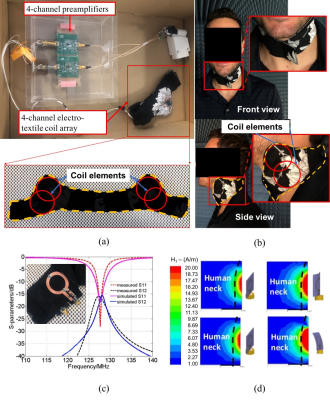 |
107 | Ultra-Flexible Electro-Textile 4-Channel MRI RF Coil Array for Neck MRI
Daisong Zhang, Le Zhang, Ashley Prosper, Holden Wu, Yahya Rahmat-Samii
Current surface coils used for neck MRI are either uncomfortable for patients to wear or suffer from low Signal-to-Noise Ratio (SNR).
|
|
1541. 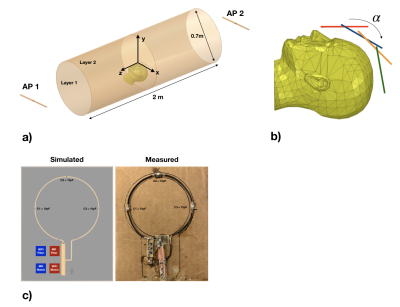 |
108 | Simulations of Integrated Radio-Frequency/Wireless Coil Designs for Simultaneous MR Image Acquisition and Wireless Communication
Julia Bresticker, Zachary Thompson, Devin Willey, Allen Song, Dean Darnell, Trong-Kha Truong
A novel RF coil design, termed an RF/wireless coil, enables simultaneous image acquisition and wireless communication by allowing currents to flow simultaneously at the Larmor and WIFI frequencies. Measurements of the far-field radiation parameters are not practical in an MRI scanner. Thus, simulations are performed to optimize the far-field performance within the scanner bore to maintain the wirelessly transmitted data integrity. In this work, finite element simulations, verified with anechoic chamber gain-pattern measurements and SNR maps from a constructed RF/Wireless coil, are performed to optimize the far-field gain, directivity, and link budget of the RF/Wireless coil within the scanner bore.
|
|
1542. 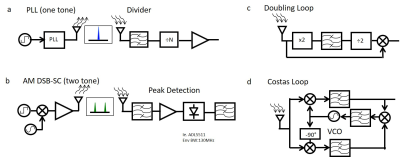 |
109 | Clock Transmission Methods for Wireless MRI: A Study on Clock Jitter & Impact on Data Sampling
Jonathan Lu, Thomas Grafendorfer, Fraser Robb, Simone Winkler, Shreyas Vasanawala, John Pauly, Greig Scott
Creating wireless MRI receive coils requires the clock for the on-coil electronics to be in phase with the clock of the MRI transmit system. Sending a wireless clock using a phase locked loop (PLL) single tone that is divided down versus a dual tone AM double side band suppressed carrier (AM DSB-SC) system can have different results in jitter of the clock. We experiment with these architectures,. The wireless clock transfer methods will ultimately impact SNR of the ADC system and its robustness to phase changes from environmental scenarios such as patient motion or multipath effects.
|
|
1543. 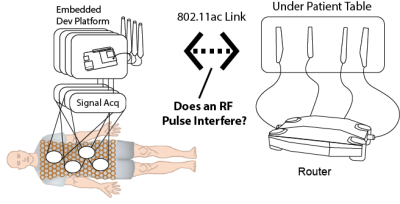 |
110 | Characterization of In-Bore 802.11ac Wi-Fi Performance
Christopher Vassos, Fraser Robb, Shreyas Vasanawala, John Pauly, Greig Scott
In the context of flexible wireless coil arrays, characterization of achievable data rates is critical. This understanding will impact the types of scans whose data rates can be achieved in a wireless framework. The MR environment includes a cylindrical reflector as well as high power RF pulses, both of which may interfere with wireless communication inside the bore. By utilizing an embedded development platform, the relative impacts of the MR environment on Wi-Fi data rate were characterized and found to have little effect on the rate of data transfer.
|
|
1544. 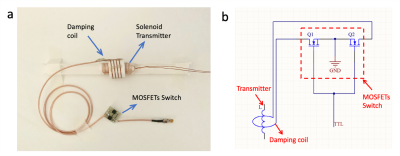 |
111 | A Novel and Efficient No-tuning Inductive-coupling Q-damping Circuit for a Low-field Portable MRI System
Zhi Hua Ren, Guang Yang, Pengde Wu, Sergei Obruchkov, Robin Dykstra, Shao Ying Huang
In a low-field portable MRI system, e.g. a permanent-magnet-based system, is
less homogeneous thus is
short. However, the ring-down of the transmit RF energy is slow, which dramatically decreases the strength of acquired signals or limits the minimum echo time for a CPMG type experiment. In this abstract, we present the design of a no-tuning inductive-coupling Q-damping circuit for transmit-coils in a low-field MRI/NMR system. The proposed circuit can effectively and quickly damp RF energy yet simple to be implemented and constructed. The effectiveness is successfully demonstrated in simulations and experimentally. In the experiment, it shows that the ring-down time is reduced by about 45%.
|
|
1545. 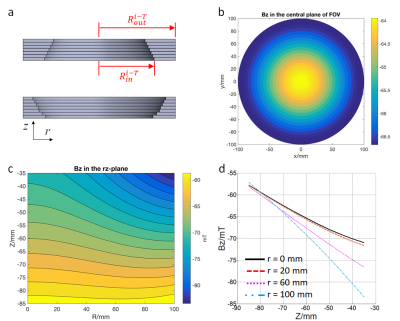 |
112 | An Aubert Ring Aggregate Magnet Helmet for 3D Head Imaging in a Low-field Portable MRI
Zhi Hua Ren, Shao Ying Huang
A permanent magnet helmet based on an Aubert ring aggregate is proposed to have a linear gradient along the axial direction for 3D head imaging in a low-field portable MRI system. It is a magnet array that consists of a series of asymmetric Aubert ring pairs, forming a Helmet shape. The inner radii of each ring are successfully optimized for a linear gradient along the axial direction, a comparably strong field strength (67.06mT), and a
|
|
1546. 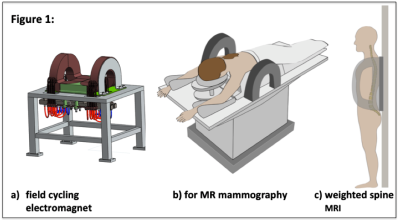 |
113 | Design of a novel class of open MRI devices with nonuniform Bo, field cycling, and RF spatial encoding
R. Todd Constable, Charles Rogers III, Baosong Wu, Kartiga Selvaganesan, Gigi Galiana
This work describes a novel approach to the design of MRI systems that combines 4 existing developments in order to create a new class of MRI devices. The developments to be described include combining parallel RF receive, Bloch-Siegert phase encoding, nonlinear spatial encoding, and field cycling. Together these methods allow for open magnets with nonuniform main fields greatly increasing design opportunities for small magnets with specific applications. The relatively low cost of this class of MR devices will allow for the placement of MRIs in doctor’s offices where they could be built into an examination table.
|
|
1547. 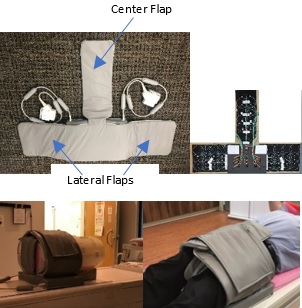 |
114 | A Novel Ultra-Flexible High-Resolution 50-Channel RF Coil for Prostate, Rectal and Pelvis Imaging
Yun-Jeong Stickle, Clyve Konrad Follante, Mark Giancola, Fraser Robb, Victor Taracila, Balint Franko, Holly Blahnik, Robert Stormont
Typically, posterior with anterior array or Large/Medium MSK coils or endorectal coil are used for prostate and rectal imaging. These coils do not provide deep depth, high-resolution and acceleration images. A novel high-resolution flexible phased-array coil for Prostate, Rectal and Pelvis Imaging is presented. This coil contains a posterior base with two lateral flaps and one center flap with wire loops providing a light weight flexible conforming coverage to prostate, rectal and pelvis. This close fitting high density 50-Channel coil provides better diagnostic images and comfort. This coil also introduces new thin flexible materials including two thermoplastic coated thin fabrics.
|
|
1548. 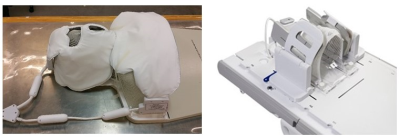 |
115 | A light-weight, flexible head and neck coil design for a patient-friendly MR-only Radiation Therapy workflow
Cristina Cozzini, Chad Bobb, Mathias Engström, Sandeep Kaushik, Robert Molthen, Dan Rettmann, Venkat Goruganti, Wen-Yang Chiang, Florian Wiesinger
MRI is known to provide a superior soft tissue contrast when compared to CT. MR simulation offers the potential of improving target and organ at risk delineation and is therefore playing an increasingly important role in the Radiation Therapy (RT) planning workflow. Here a lightweight, highly flexible, novel coil prototype for head and neck is presented, demonstrating that a patient friendly MR-only simulation workflow for standard MR imaging and pseudo CT conversion is feasible in a clinical setting and compatible with RT fixation devices.
|
|
1549. 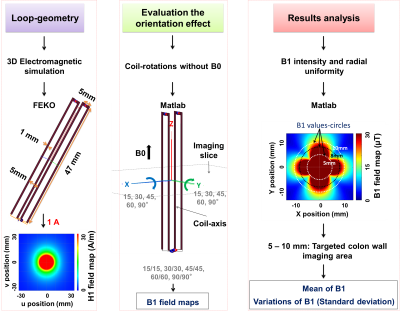 |
116 | Design of a reconfigurable endoluminal coil using MEMS switches
Hamza Raki, Kevin Tse Ve Koon, Henri Souchay, Fraser Robb, Simon A. Lambert, Olivier Beuf
Endoluminal Magnetic Resonance Imaging (MRI) is an alternative solution to conventional MRI, which is still not sufficient to image the bowel and colon wall. However, it mainly suffers from coil-sensitivity-map variations with coil-orientations within respect to the main magnetic field (B0). The purpose of this work was to study numerically different coil-geometries and their performances when positioned in different orientations regarding B0. From the simulation results, a solution of a reconfigurable endoluminal-coil using four MEMs switches is proposed. Electro-Magnetic (EM) simulation demonstrated the feasibility to reduce the coil-sensitivity variations by using a combination of Single-loop (SL) and Double-Turn-Loop (DTL) configurations.
|
|
1550. 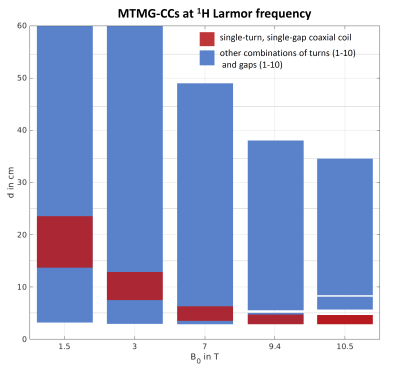 |
117 | Flexible multi-turn multi-gap coaxial RF coils: enabling a large range of coil sizes
Raphaela Czerny, Lena Nohava, Roberta Frass-Kriegl, Jacques Felblinger, Jean-Christophe Ginefri, Elmar Laistler
Flexible single-turn coaxial RF coils with one gap in the outer and one gap in the inner conductor are restricted to a specific geometry, determined by the target resonance frequency and the specifications of the cable used. In this work we demonstrate by numerical simulations that, by combining the concept of coaxial coils with that of multiple turns and gaps transmission line resonators (MTMG TLRs) and the additional degree of freedom offered by varying the cable parameters, a large diameter range can be achieved to design 1H RF coaxial coils for most common B0 field strengths.
|
|
1551. 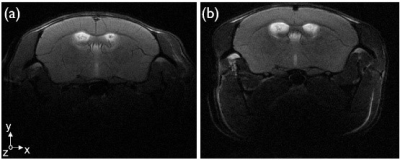 |
118 | A Transceive Inductively Coupled Coil using Dual Wireless Coils for Small Animal Imaging at 15.2T
SooBum Kim, DongHyuk Kim, Won Beom Jung, KyungNam Kim
The ultrahigh field 15.2 T Magnetic Resonance Imaging (MRI) is characterized by high magnetic flux density (B1) sensitivity and uniformity. Therefore, it is mainly used for small animal images requiring high resolution. Generally, surface coils are used to obtain high B1 sensitivity to target brain at small animal MRI, but occasionally there is insufficient coverage to cover all of the Region of Interest, so that the desired information may not be obtained. In this study, we propose a coil with wider coverage using inductively coupling by adding dual wireless coils to one channel transceive primary coil at 15.2 T.
|
|
1552. 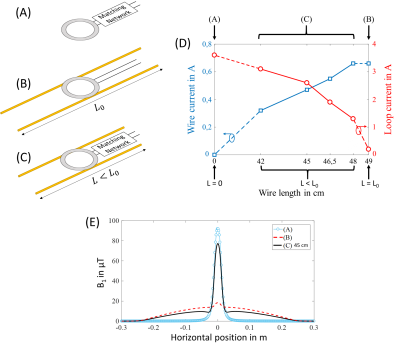 |
119 | Resonant and non-resonant coupled-wire coils for small-animal multinuclear imaging
Tania Vergara Gomez, Marc Dubois, Stanislav Glybovski, Benoit Larrat, Julien de Rosny, Carsten Rockstuhl, Monique Bernard, Redha Abdeddaim, Stefan Enoch, Frank Kober
Metasurface coils coupled with an unmatched loop were suggested earlier as an alternative to classical surface and volume coils, with the aim to optimize volume and sensitivity. We developed a new approach combining a commercial surface coil and a non-resonant coupled-wire structure. With this approach, the signal contribution from the driving loop can be efficiently added to that of the wire surface. The configuration was simulated, built and tested for 1H and 19F at 7T. The results showed that this new strategy improves the coil's sensitive volume while simultaneously maintaining high SNR.
|
|
1553. 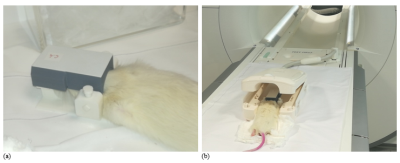 |
120 | Imaging of Stroke in Rats using a Clinical Scanner and an Inductively Coupled Specially Designed Receiver Coil
Ignacio Iñigo, Javier Istúriz, Miguel Fernández, Maria J. Nicolas, Pablo Domínguez, Gorka Bastarrika , Miguel Valencia, María A. Fernández-Seara
Imaging of small laboratory animals in clinical MRI scanners is feasible but challenging. Compared with dedicated preclinical systems, clinical scanners have relatively low main field (1.5 – 3.0 T) and gradient strength (40 – 60 mT/m). This work explores the use of wireless inductively coupled coils combined with adapted pulse sequences to overcome these two drawbacks, with a special emphasis on the optimization of the coil passive detuning circuit for this application. The images of rat brain stroke obtained show a substantial increase in SNR compared to clinical coils, and the absence of wires makes the animal preparation workflow straightforward.
|
|
1554. 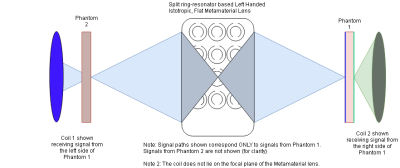 |
121 | Title: Enhancement of SNR and Sensitivity of Image in MR using Left Handed Metamaterial Lens Focusing/Converging in both direction. Presentation Not Submitted
Tejkiran Patil, Bhaskara Naik, Rajesh Harsh
Enhancement of the signal received by the surface coil is one of the interesting area to increase the SNR. Left Handed Metamaterial Lens have shown application in MRI to increase the signal strength at its converging point. We have reported the increase in receiver sensitivity by around 5 dB. In this report SNR and Sensitivity is further improved by incorporating metamaterial lens in between 2 receive chain of a 4-channel hexagonal shaped flex array coil is presented. With this method SNR is improved by 1.4 times.
|
|
1555.  |
122 | Investigation of antenna effect on non-contact monitoring of heart and respiration rate
Takafumi Ohishi
This paper investigates a non-contact heart and respiration rate monitoring with antennas. In order to examine antenna effect on the non-contact monitoring, differences of antenna resonant frequency or antenna type are investigated by experiment. In the experiment, it is found that the higher the antenna resonant frequency is, the easier the heart rate is identified. In addition, it is shown that by using only one open circuit end type dipole antenna, both the heart and respiration rate in spine posture can be identified.
|
|
1556. 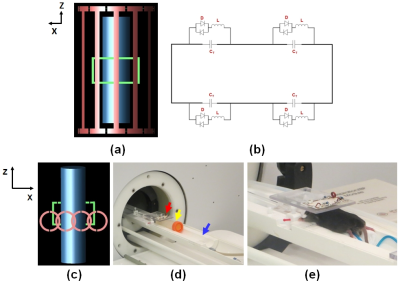 |
123 | Sensitivity and Uniformity Improvement of Phased Array MR Images Using Inductive Coupling and RF Detuning Circuits
Bu Park, Sunder Rajan, Brent McCright
This study demonstrates improvement in MR image sensitivity and uniformity from a 4-channel phased array using a secondary resonator having switchable detuning circuits. The secondary resonator was located at the opposite side of the 4-channel phased array to improve sensitivity and uniformity of the acquired MR images. The numerical simulation results of |B1+| in a transmit mode showed the magnetic field uniformity would be decreased with the designed secondary resonator having no detuning circuits because of unwanted interferences between the transmit birdcage coil and the secondary resonator. Whereas, the sensitivity and uniformity of |B1-| in a receive mode were improved with the secondary resonator and a 4-channel phased array. For experimental verification, a uniform saline phantom and mice were analyzed by MR using a 7.0T small animal MRI system.
|
|
1557. 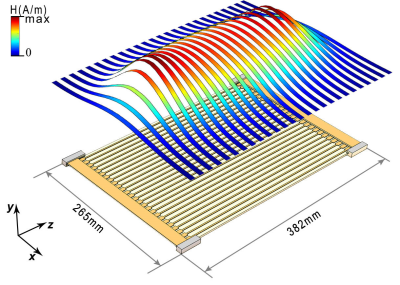 |
124 | Metasurface-based wireless coil to control RF magnetic field distribution inside 1.5T MR scanner.
Egor Kretov, Alena Shchelokova, Alexey Slobozhanyuk
We demonstrate a new metasurface-based wireless coil for 1.5T MRI. A simple working frequency adjusting method let using it in a wide frequency range up to 5 MHz that make it compatible with MRI systems of different manufacturers. The design of the coil allows manipulating the radiofrequency magnetic field profile inside the large body coil improving its transceive efficiency in the target area. Phantom imaging with proposed coil approves that by changing the size of the working region is also possible to decrease the excitation power needed to provide optimal flip angle.
|
|
1558. 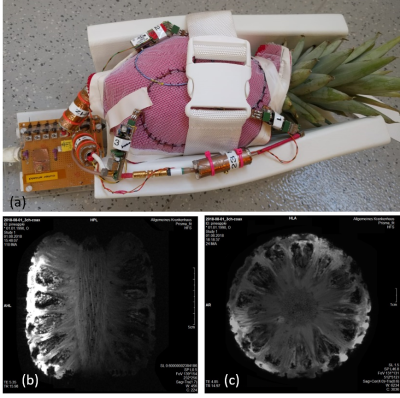 |
125 | Ultra-flexible and light-weight 3-channel coaxial transmission line resonator receive-only coil array for 3T
Michael Obermann, Lena Nohava, Sigrun Goluch-Roat, Michael Pichler, Jürgen Sieg, Jacques Felblinger, Jean-Christophe Ginefri, Elmar Laistler
An ultra-flexible light-weight coaxial coil array with compact interfaces is introduced. The interfaces consist of components for tuning, active detuning, matching and preamplifier decoupling. Bench and MR tests of the array are presented and the robustness with regard to bending is demonstrated.
|
Digital Poster
| Exhibition Hall | 09:15 - 10:15 |
| Computer # | |||
1559.  |
126 | A PIN-diode-driver for fast coil tuning using low detune currents
Michael Eder, Andreas Horneff, Erich Hell, Johannes Ulrici, Volker Rasche
To operate ultra short echo time (UTE) or zero echo time (ZTE) imaging, the ability to switch rapidly from detuned to tuned state is mandatory, as any delay causes signal loss for UTE or missing data points in the k-space center for ZTE. While propagation delays arising during radio frequency (RF) front end control can be measured and compensated, the dead time of the receive coil remains a limiting factor. In this contribution we investigated an approach to speed up PIN-diode based coil-tuning, using a dedicated driver providing a low detune current. Tuning times below could
be realized.
|
|
1560.  |
127 | UTE and ZTE on an unmodified clinical whole-body MR system using an RF signal acquisition system operating in parallel achieving an acquisition delay of less then 
Michael Eder, Andreas Horneff, Jan Paul, Alexander Storm, Erich Hell, Johannes Ulrici, Volker Rasche
Ultra short echo time and zero echo time imaging on clinical systems are, even on modern systems, still limited by the rather long transient time required for switching from transmit to receive mode. In this contribution a complete receive-only chain was interfaced to an unmodified clinical whole-body MR system. Synchronization is achieved by a single trigger line as temporal reference and a time base signal, thus ensuring minimal interference and phase synchronous operation in parallel to the clinical system. An acquisition delay, between the real end of the excitation pulse and the beginning of signal acquisition, below could
be realized.
|
|
1561. 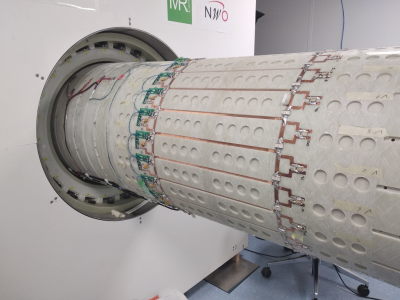 |
128 | Necessity for detuning large volume coils?
Ria Forner, Martijn Lunenburg, Quincy van Houtum, Ladislav Valkovic, Jane Ellis, Christopher Rodgers, Dennis Klomp
Implementing diode detuning on transmit coils is complicated and leads to a loss in efficiency on the transmit side. It has been common practice to include it nevertheless with the aim of preventing loss of receive efficiency and noise correlation between receiver through coupling via the body coil. However, nowadays, receiver coil elements are orders of magnitude smaller so flux linkage is intrinsically low. Moreover, the operating frequency is high to maintain strong tissue-loading, and finally preamplifier decoupling is applied to reduce the effects of mutual coupling. Here we show the coupling to receiver arrays for three non-detuned body coils.
|
|
1562. 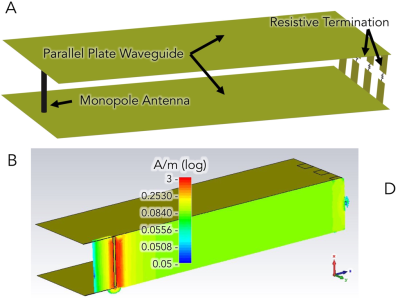 |
129 | Traveling-Wave Excitation for Electron Paramagnetic Resonance Imaging
Bahareh Behzadnezhad, Nader Behdad, Alan McMillan
One primary factor limiting the extension of electron paramagnetic resonance imaging (EPRI) beyond small animal applications is the challenge of create uniform RF fields at the higher RF frequencies needed to achieve the desired sensitivity. In this abstract, we discuss the development of a traveling-wave spectrometer operating in continuous-wave mode at 115 MHz. The spectrometer uses a parallel-plate waveguide supporting transverse electromagnetic waves to create a uniform transmit field and uses a conventional receive coil. We demonstrate the feasibility of a traveling wave system and its potential to be developed into an EPR imaging system.
|
|
1563. 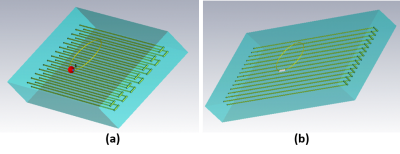 |
130 | A switch matrix to enable passive cloaking of a metasurface resonator for MRI applications
Shimul Saha, Roberto Pricci, Maria Koutsoupidou, Ditjoni Katana, Srinivas Rana, Helena Cano-Garcia, Panagiotis Kosmas, George Palikaras, Efthymios Kallos
We present a switch matrix for automatic tuning and detuning of a metasurface-resonator employed to enhance MRI scanning performance. A digital circuit with an inductor was used to pick up the magnetic field and generate a clock for switching which does not require any wire connection to the MRI scanner. The clock was used to activate an array of MOSFET switches, each of them connected to an adjacent pair of parallel wires of the resonator. The circuit was tested using a solenoid and the metasurface resonance frequency was successfully tuned and detuned (cloaked) when the magnetic field was off-on respectively.
|
|
1564. 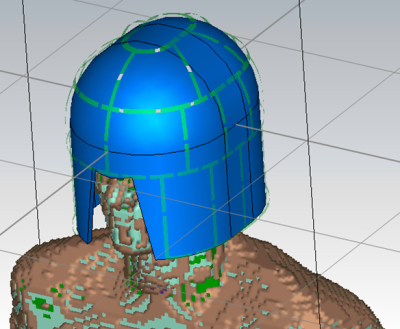 |
131 | Effects of Parallel Imaging Acceleration on SNR Improvement with a High-Permittivity Helmet Shaped Former at Different Field Strengths
Giuseppe Carluccio, Bei Zhang, Riccardo Lattanzi, Gregor Adriany, Kamil Ugurbil, Christopher Collins
Use of high-permittivity materials has recently shown very promising results in terms of reduction of B1 inhomogeneities and increase of SNR. In particular, significant SNR increases have been predicted for a high-permittivity helmet former within a close fitting head array. With this solution, for a 7T MRI system, an average SNR increase approaching 50% was obtained in the brain with SNR peak improvements of more than 200%. Until now, however, the effects of the high-permittivity helmet on g-factor and parallel imaging have not been examined. In this work, for three different acceleration rates we evaluate the impact of gfactor when a high-permittivity helmet shaped former is used in two different head arrays at two different field strengths.
|
|
1565. 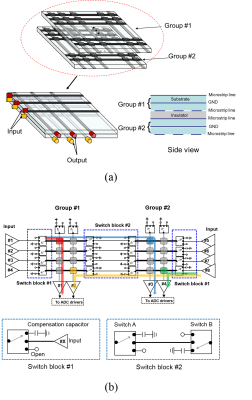 |
132 | The miniaturisation and simplification of a crossbar switch matrix system using stacked switch blocks
Yunkyoung Ko, Chang-Hoon Choi, N. Shah, Jörg Felder
The crossbar-type matrix creates open-stubs of varying length, depending on the switch configuration, which potentially degrades the MR image quality. However, this issue can be overcome efficiently with the use of a compensation circuit. But as the number of receive coils increases, a larger number of RF switches is required. In this study, we propose a miniaturised crossbar switch matrix which employs two independent, stacked boards.
|
|
1566. 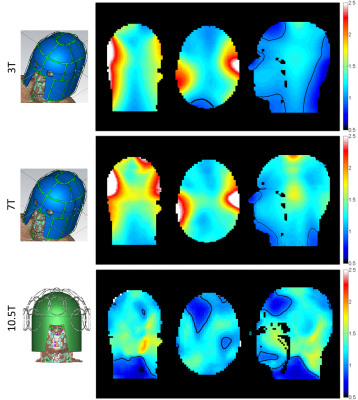 |
133 | On the Relationship Between Field Strength and Permittivity for Desired Effects of High-Permittivity Materials in MRI
Christopher Collins, Giuseppe Carluccio, Bei Zhang, Gregor Adriany, Kamil Ugurbil, Riccardo Lattanzi
Experience and general understanding dictate that greater relative permittivity is required to produce a similar effect at lower B0 field strengths and B1 frequencies. Here we use some fundamental explanations and preliminary numerical results for improving receive array performance at different field strengths to propose, more specifically, that permittivity should increase approximately with the inverse of the square of the field strength for an expected effect.
|
|
1567.  |
134 | MEMS-based Ratio Adjustable Power Splitters for in-bore Switching of Transmit Array Compression Networks
Charlotte Sappo, Gabriela Gallego, Xinqiang Yan, William Grissom
A large number of coils in parallel transmission enables higher excitation accuracy with lower SAR, but the high cost and siting challenges associated with
|
|
1568. 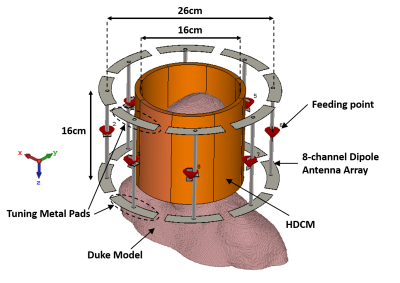 |
135 | Effect of high dielectric constant material configurations on the transmission field of an 8-channel dipole array at 10.5 T (447 MHz)
Navid PourramzanGandji, Sebastian Rupprecht, Michael Lanagan, Bei Zhang, Riccardo Lattanzi, Russell Lagore, Jerahmie Radder, Gregor Adriany, Kamil Ugurbil, Qing Yang
We used numerical simulations to investigate the effect of high dielectric constant materials (HDCM) on the performance of a transmit array with 8 dipole antennas for 10.5 T head MRI. Several parameters, including B1+ transmit efficiency, coupling between each array elements, and Specific Absorption Rate (SAR), were evaluated in the presence of HDCM with various relative permittivity values. We show that employing HDCM can decrease the coupling between each adjacent element by 16%, increase B1+ efficiency by more than 30% and lower total SAR by 40%.
|
|
1569. 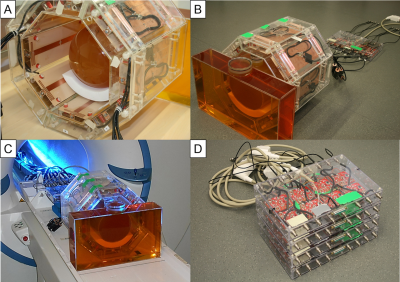 |
136 | Quality assurance of 8-channel transmit/receive switches for a 32-channel transmit/receive system at 7T UHF MRI
Stefan Rietsch, Maximilian Voelker, Stephan Orzada, Daniel Leinweber, Mark Ladd, Harald Quick
With increasing number of transmit and receive channels it becomes more and more important to monitor the behavior of the RF chain over time since weaknesses of custom-built hardware need to be known to the investigator. In this work, a quality assurance procedure for four identical 8-channel transmit/receive switchboxes for a 32-channel transmit/receive MR system at 7T is presented. In repeated measurements of a homogeneous phantom with an 8-channel transmit/receive coil, metrics like flip angle distribution, SNR and noise correlation are used to automatically assess quantitatively if significant changes of the hardware did occur.
|
|
1570. 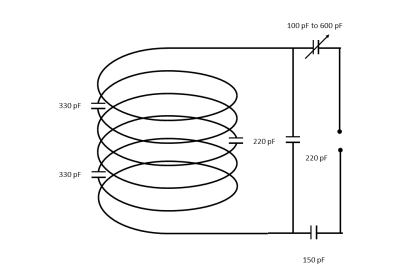 |
137 | Bilateral Breast coil for Fast Field-Cycling Relaxometric MRI
Gareth Davies, Lionel Broche, Tanja Gagliardi, David Lurie, P. Ross
Our research group is investigating the use of Fast Field-Cycling MRI (FFC-MRI) for clinical applications. Recent results have confirmed the presence of interesting FFC-MRI biomarkers in breast cancer that could lead to important applications. To study this we are developing an FFC-MRI compatible breast coil for use on patients. This work is presented here and shows excellent results, paving the way to clinical applications.
|
|
1571. 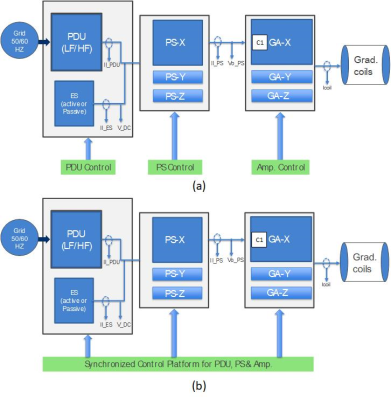 |
138 | Control synchronization of power supplies and gradient amplifiers for better utilization of energy storage in MRI scanner
Yash-Veer Singh, Juan Sabate, Ruxi Wang, Viswanathan Kanakasabai, Krishna Mainali, Huan Hu
The magnetic resonance imaging (MRI) gradient driver is a high-performance inverter that provides large peak currents, >1000A, for the gradient magnetic fields used for imaging. MR system has capacitors for energy storage at the amplifier stage input voltages. Volume/weight reduction in energy storage elements is one of the challenging issue in design of compact and efficient MRI gradient system. It is possible to reduce capacitance value in energy storage elements by synchronizing the control of the gradient driver different subsystems. Control synchronization is achieved by providing reference value of coil current simultaneously to the different controller of the MRI system.
|
|
1572.  |
139 | A three-element triple-tuned array implemented with switchable matching and tuning
Travis Carrell, Romina Del Bosque, Matthew Wilcox, Mary McDougall
This work describes a geometrically decoupled three-element array triple-tuned for 1H, 13C, and 31P at 3T implemented with switchable matching and tuning using PIN diodes. These particular nuclei were chosen to demonstrate the frequency range of the method, but the approach is extendable to any nuclei of interest. Although the Q of the coils was degraded by the switching network, the use of PIN diodes enabled straightforward tuning and development.
|
|
1573.  |
140 | On the minimum phase control required for B1 shimming
Steven Wright
Phase only B1 shimming is a cost-effective and simple approach to improving RF field homogeneity for high field MRI. Without a multiple channel transmitter, this is implemented by switching transmission lines or possibly lumped element phase shift networks. This abstract investigates the minimum phase shift required in a potential multi-bit electronic phase shifter. For practical shimming solutions, those not requiring significant increases in power to achieve a 90 degree tip angle as compared to ‘birdcage’ or conjugate phase currents, it is concluded that 45 degrees may be a sufficient resolution for such a phase shifter.
|
|
1574. 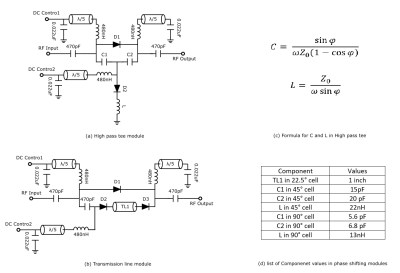 |
141 | Digitally Controlled High-Power Phase Shifter for B1 Shimming at 7T
Chenhao Sun, Neal Hollingsworth, Kevin Patel, Kasra Ghadiri, Chung-Huan Huang, Steven Wright
To mitigate electromagnetic wave interference in high field MRI, RF shimming relies on the ability to manipulate the phase and amplitude of the Tx signal on each channel. The simplest approach is to change phase shifts by switching transmission lines. We propose an electronically controlled phase shifter providing eight different states of phase shifting (0°, 22.5°…...135°, 157.5°), designed to handle 1kW Tx power and is non-magnetic so that it can be used in the magnet room. Measurement demonstrate an average insertion loss of -0.94dB and an average phase error -1.35° compared with design values.
|
|
1575. 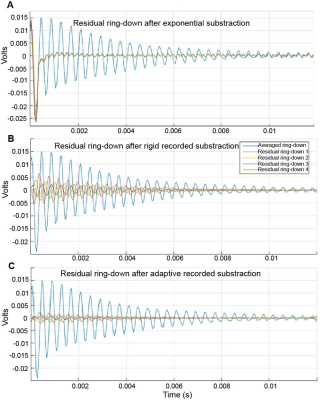 |
142 | Receiver ring-down attenuation for Ultra-Low field MR
Ruben Pellicer-Guridi, Michael Vogel, Rainer Körber, Jan-Hendrik Storm, Jiasheng Su, David Reutens, Viktor Vegh
Ultra-low field MR detector coils experience long dead-times which reduce acquisition efficiency. We present a simple low insertion loss Q-damping scheme and a post-processing method that, combined, allow earlier signal acquisition. Proposed methods have been empirically verified with a cylindrical detector at 2.5 kHz. This approach can improve imaging efficiency for ULF MR considerably, promoting the use of inexpensive resistive coils for low-cost, portable ULF MR instruments.
|
|
1576. 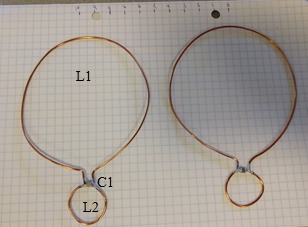 |
143 | Self-decoupled coils for MRI receiver arrays based in an external resonator
Rafael Baron, Juan Sanchez-Heredia, Vitaliy Zhurbenko, Jan Ardenkjær-Larsen
A method of decoupling coils by the use of an external resonator has been developed. The method provides several advantages as a decoupling strategy which does not strongly depend on the input impedance of the amplifier, can use flexible wires and provide a low dependence of the coupling to the position of one coil relative to the other. The concept was initially developed for cryogenic coils due to its simple implementation but is presented to room temperature Copper-based receivers.
|
|
1577. 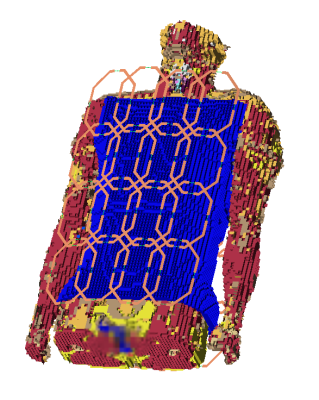 |
144 | Massively Accelerated Simulations of High-Permittivity Materials in Multi-Channel Receive Arrays
Wyger Brink, Jeroen van Gemert, Peter Börnert, Rob Remis, Andrew Webb
High-permittivity materials are known to offer potential increases in the sensitivity of RF coils, increasing SNR or reducing SAR. Design guidelines are not straightforward, however, in part due to complex coil interactions. We here present a numerical method for the rapid (e.g. ~1 sec) assessment of dielectric materials positioned in a 3T torso receive array, enabling full exploitation of this technology.
|
|
1578. 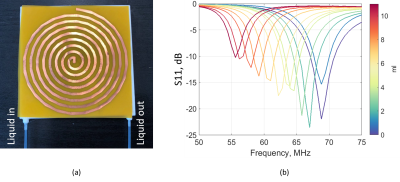 |
145 | Water-tunable Spiral Metamaterial Resonator for Radiofrequency Field Enhancement for Receive Coils at 1.5T
Elizaveta Motovilova, Srikumar Sandeep, Michinao Hashimoto, Shao Ying Huang
We present a low-profile tunable spiral metamaterial resonator for radio-frequency field enhancement and penetration increase for receive coils at 1.5T MRI. The resonator consists of a dielectric substrate with a cavity for water deposition and two conducting spirals placed on each side of the substrate. The proposed structure is placed between a receive loop-coil and a load. The resonance frequency of the coil-spiral system can be varied within a range of 15MHz by changing the water volume in the cavity from 0ml to 12ml. The system shows a magnetic field refocusing and enhancement with a considerable increase in penetration depth.
|
|
1579.  |
146 | Shunt, don't block: A New Approach to Dual Nuclear Coil Design.
Matthew Erickson
Development of dual nuclear coils with high efficiency on both 1H and X remains a challenge. The advent of hyperpolarized 13C imaging and hyperpolarized rare gas imaging has provided impetus for developing such a coil. In this work, we report prototype 1H/13C surface coil that makes use of tune/match circuits augmented by high performance shunt notch filters constructed from hybrid transmission line circuits. In this design, all conductive elements in the utility region are simultaneously resonant with high efficiency on both 1H and X. The design may be extended to both volume and array coils for most 1H/X pairs.
|
|
| 1580. |
147 | A triple tuned coil and front-end for simultaneous multinuclear MR imaging and spectroscopy
Chung-Huan Huang, Hongli Dong, Stephen Ogier, Chenhao Sun, Steven Wright
There are several ways to implement simultaneous acquisition for multiple nuclei. A single-port triple tuned coil is the simplest structure and has the best potential for integration into multiband arrays. This abstract demonstrates an approach to acquire three nuclei (1H/23Na/2H) MRS simultaneously by using a home-built broadband spectrometer with a triple tuned coil. The broadband spectrometer front-end is capable of providing separate gains to each of studied nucleus where signal sensitivity variation is large and can reduce data throughput load by using undersampling techniques while still maintaining similar performance as a Varian Inova system.
|
|
1581. 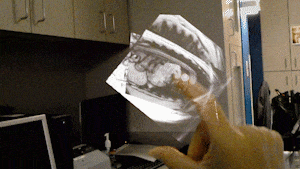 |
148 | Interactive hand gestures for HoloLens rendering control of real-time MR images
Andrew Dupuis, Dominique Franson, Nicole Seiberlich, Mark Griswold
User interactions via hand gestures are added to a real-time data acquisition, image reconstruction, and mixed-reality display system to allow a user to interact more flexibly with the rendering. Images at precalibrated slice locations are acquired and displayed in real-time to the user, who is able to toggle between viewing some or many slices as well rotate, resize, and dynamically adjust the window and level of the rendering.
|
|
1582. 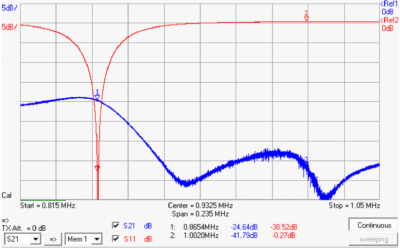 |
149 | Dynamic Dual Frequency Transmit and Receive Coil Pair for Development of a New Open MRI System
Charles Rogers III, Gigi Galiana, Todd Constable
We present progress on development and testing of a two-coil array with each coil separately and dynamically tunable between dual frequencies. This test setup works toward the goal of developing a larger nine-element coil array for a new style of open MRI system utilizing the Bloch-Siegert shift at low Bo field. The array design is such that pairs of coils are selected for transmission at ~850kHz while allowing simultaneous receive at ~1MHz on the non transmitting coils. We discuss the construction and present measurements of RF scattering parameters of a two-coil test setup.
|
|
1583. 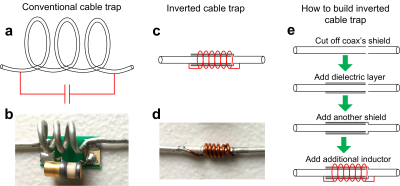 |
150 | A highly-miniaturized inverted cable trap
Xinqiang Yan, John Gore
Cable traps are commonly used for RF coils to suppress the common-mode current flowing on the outer conductor of coaxial cables. In massive-element array coils, conventional cable traps become cumbersome and not easy to assemble due to the limited space. In this work, we propose a novel circuit component called an “inverted cable trap”, which uses the outer conductor of a coaxial cable to form a capacitor rather than an inductor and which can be highly miniaturized. This inverted trap suppresses common-mode signals by up to -23 dB at 300 MHz which makes it valuable for operations at 7T.
|
Digital Poster
| Exhibition Hall | 09:15 - 10:15 |
| Computer # | |||
1584. 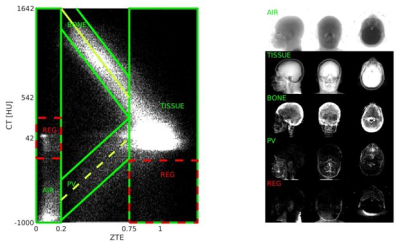 |
151 | MR to pseudo CT conversion: Combining Deep-Learning and Analytical Image Processing
Florian Wiesinger, Sandeep Kaushik, Mathias Engström, Pauline Hinault, Andrew Leynes, Mikael Bylund, David Gensanne, Tufve Nyholm, Peder Larson, Cristina Cozzini
Here we present an improved method for ZTE to pseudo CT conversion by combining an analytical signal model (i.e. ZTE to CT signal scaling) with Connected Component Analysis (CCA) and Deep Learning (DL) based air vs. bone discrimination. The method is demonstrated for the two main anatomical regions (head&neck and pelvis) and the two main field strengths (1.5T and 3T) of interest.
|
|
1585.  |
152 | First MRI of the human spinal cord at 9.4T
Ole Geldschläger, Saipavitra Manohar, Andrew Wright, Nikolai Avdievitch, Anke Henning
This study presents the first anatomical images of the human cervical spinal cord recorded at the ultrahigh ?eld strengths of 9.4 T. The images were acquired with a Gradient-Echo-Sequence. Different sequence parameters and resolutions were compared. The highest in-plane resolution was 0.2 mm x 0.2 mm. These high-resolution images show the details of the spinal cord and the surrounding tissue clearly. All measurements were acquired with an 8-channel transmit-, 16-channel receive-tight-fit array coil, originally dedicated for brain applications.
|
|
1586 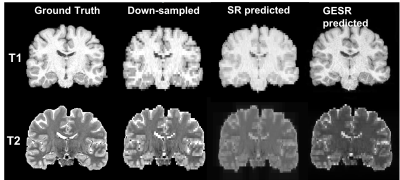 |
153 | An generalized single MR image super resolution approach using combined super-resolution network and cycle-consistent adversarial network Video Permission Withheld
Botian Xu, Yaqiong Chai, Kangning Zhang, Natasha Lepore, John Wood
Traditional inception-based convolutional neural networks (CNN) are proved to be capable of tackling high resolution image restoration, yet they are poor at generalization due to the supervised learning procedure. We proposed a combination of CNN-based super resolution network and generative adversarial network, to make full use of the learning of high resolution from CNN, as well as to improve the generalization of the network, by preserving the original contrast of the sequence. The result shows that our proposed network could perform MR super resolution across sequences with higher quality than that from a single CNN network.
|
|
1587. 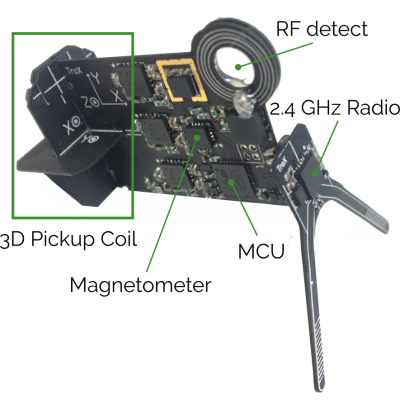 |
154 | Robust detection and potential application in orientation tracking of a small-amplitude field oscillation independent of location in the scanner bore and parallel to the static magnetic field.
Adam van Niekerk, Andre van der Kouwe, Ernesta Meintjes
We explore the possible uses of a 40-kHz switching signal that is proportional to the gradient slew rate. The signal was identified by probing the rate of change of the magnetic flux density in the MRI scanner using a three-dimensional pickup coil. The signal is independent of both the orientation of the pickup coil and location in the scanner bore, and is directed parallel to the static magnetic field. This indicates that it is not caused by current in the gradient coils. These properties make this signal a useful vector reference that could be used for orientation tracking or time frame synchronisation.
|
|
1588. 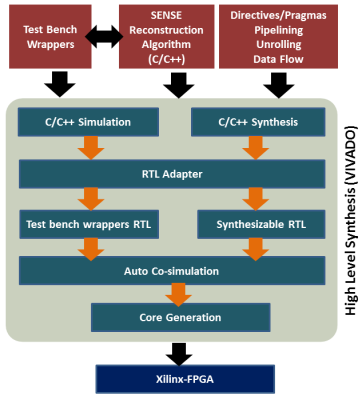 |
155 | FPGA-based coprocessor for real-time SENSE reconstruction: Design and Implementation
Abdul Basit, Omair Inam, Hammad Omer
In real-time clinical settings, high speed systems have become imperative to meet the large data processing requirements of parallel MRI algorithms e.g. SENSE. Field-Programmable-Gate-Arrays (FPGAs) have recently emerged as a viable solution to adhere the rising demands of fast data processing by exploiting the inherent parallelism of SENSE reconstruction algorithm. This paper presents the first design effort to implement high performance 32-bit floating-point FPGA-based coprocessor for real-time SENSE reconstruction using high-level-synthesis (HLS) frame work. In-vivo results of 8-channel 1.5T human-head dataset show that the proposed system speeds up the image reconstruction time up to 1000x without compromising the image quality.
|
|
1589. 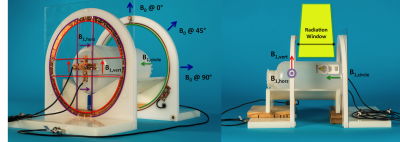 |
156 | Circumventing Radiation Beam and RF-Coil Collisions in a Rotating B0 Linac-MR Hybrid using a Three-channel Array
Vyacheslav Volotovskyy, Radim Barta, Keith Wachowicz, Nicola De Zanche, B. Gino Fallone
Hybrid radiation therapy and magnetic resonance imaging (MRI) systems are providing new options for cancer therapy. In our design the B0 rotates on a gantry along with the linear accelerator (linac) for treatment delivery. This introduces new challenges to RF-coil design as the plane of MR precession changes depending on gantry angle. Our three channel array is appropriate for the head and consists of two butterfly coils and a circular loop. The array provides equal SNR at all gantry angles while allowing a radiation window to avoid collisions between the radiation beam and the RF-coils.
|
|
1590. 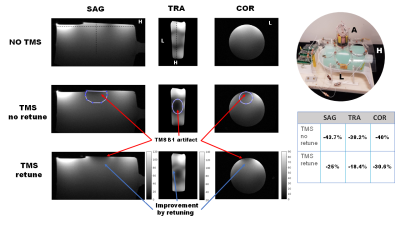 |
157 | Designing a multichannel TMS/MRI system for 3 T: a 7-channel RF receive-only coil array prototype
Lucia Navarro de Lara, Anthony Mascarenas, Douglas Paulson, Sergey Makarov, Jason Stockmann, Lawrence Wald, Aapo Nummenmaa
An integrated multichannel TMS/MRI head coil array for 3T is currently under development to enable electronically controlled multifocal TMS with concurrent whole-head fMRI. To test the feasibility of the proposed RF hardware design, a 7-channel RF receive-only coil array prototype was built. Calculated B+1 maps showed the attenuating effect of the TMS coil on the transmit field. The improvement by retuning the affected RF loops was demonstrated using MPRAGE images. Functional images showed no additional artefacts when TMS pulses were interleaved between the EPI volumes. The prototype results support our RF hardware design approach for the TMS/MRI system.
|
|
1591. 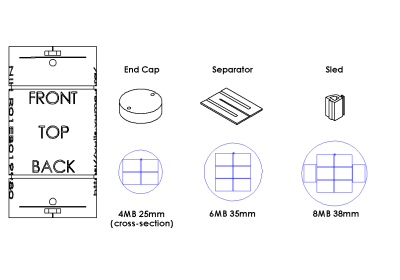 |
158 | 3D Printed Mouse Brain Holders for High Throughput Ex Vivo MRI
Dong Kyu Kim, Autumn Greenfield, Mark Does
High throughput MRI of ex vivo mouse brains has been established as a powerful tool for studying mouse models of neurological disorders. These studies have used a RF coil array to image up to 16 mouse brains simultaneously; however, most pre-clinical MRI facilities are not equipped with multiple receivers and may not have a high field magnet with sufficient bore size to accommodate multiple coils. Here, we present designs for 3D-printed multiple mouse brain holders that can be produced inexpensively and enable high quality multiple mouse brain MRI with RF coils ≥ 25 mm diameter.
|
|
1592. 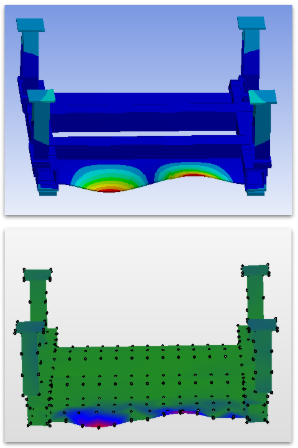 |
159 | Preliminary Investigation of the Vibration Characteristics and Isolation Requirements of a Prototype MRI Scanner
Genevieve Rodrigue, Chris Mechefske
A persistent issue with MRI scanners is inadequate vibration isolation. The objective of this work is to implement vibration isolation in a prototype MRI scanner base to minimize stringent and costly structural requirements for MRI suites. To first use a computational model of an MRI base as an analysis tool, modal analysis has been conducted to validate the model. Furthermore, analysis of a pneumatic isolator has been completed to assess its suitability to the MRI application. Testing demonstrated adequate performance of the isolator under most expected loading cases. Computational analysis of an idealized isolator model supports the experimental results.
|
|
1593. 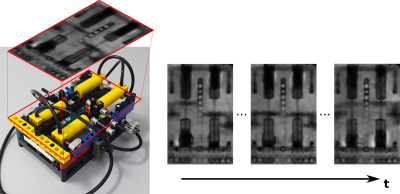 |
160 | Plastic Bricks in MRI: An Efficient Way to Build Static and Dynamic Phantoms
Nick Scholand, Sebastian Rosenzweig, Felix Ertingshausen, Martin Uecker
Novel MRI techniques are typically tested on phantoms, hence static and dynamic phantom setups are required during development. However, MRI phantoms are either off-the-shelf components which are expensive and not very flexible or are custom-built which is time-consuming and often requires specialized equipment. Here we report our experience using plastic bricks to build a variety of static and dynamic phantoms.
|
|
1594. 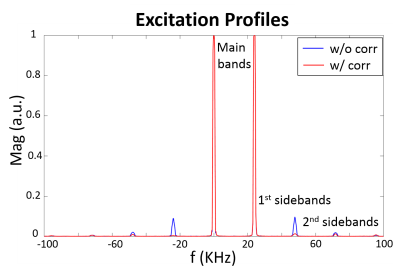 |
161 | A method for suppressing simultaneous multi-slice (SMS) imaging artifacts caused by RF distortions
Yuan Zheng, Yu Ding, Qing Wei, Rongxing Zhang, Weiguo Zhang
In simultaneous multi-slice (SMS) imaging, the multi-band RF pulses have complicated waveforms and may suffer from distortions, which can cause sideband excitations and result in image artifacts. We have proposed a simple method for correcting the RF distortions using a prescan of the RF output, which can be conveniently integrated in general SMS applications to suppress such artifacts with a negligible increase of scan time.
|
|
1595. 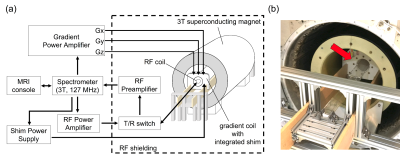 |
162 | A 3T MRI platform for imaging rodent models by integrating a dedicated high-strength gradient coil on a whole-body magnet
Sheng-Min Huang, Kuan-Hung Cho, Ming-Jye Chen, Hsuan-Han Chiang, Chang-Hoon Choi, Richard Buschbeck, Ezequiel Farrher, N. Jon Shah, Ruslan Garipov, Ching-Ping Chang, Hsu Chang, Li-Wei Kuo
In this study, a high-strength gradient coil dedicated for imaging rodent models has been successfully integrated on a whole-body 3T MRI magnet. The imaging capability of this system has been qualitatively and quantitatively demonstrated using phantom, ex-vivo specimen and in-vivo rat experiments. Since the hardware components used for integration on our system are independent from system vendors, this study can be a practically useful guide, especially for those who want to conduct small animal imaging on clinically used magnets.
|
|
1596. 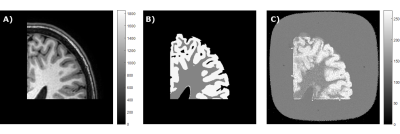 |
163 | Solid material resembling human tissues:a white and gray matter brain phantom.
Manuel Chapa, Hernán Valenzuela, Cristán Montalba, Sergio Uribe, Macelo Andia, Flavia Zacconi, Cristán Tejos
In this work we present a solid brain phantom that resemble the anatomy and T2 relaxation times of the brain. The developed material is a 3-component mix. Adjusting the relative concentration of the compounds allow to modulate T2 relaxation time, following a linear relationship within a range of 145 to 263ms. The resulting solid phantom can reproduce correctly the geometry of white and gray matter. The range of achievable T2 relaxation times makes possible the construction of phantoms that could mimic a wide range of biological tissues.
|
|
1597. 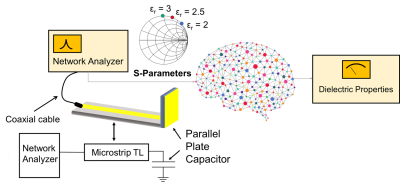 |
164 | Rapid Material Characterization For 3D-printed MRI Coils: A Deep Learning Approach
Bahareh Behzadnezhad, Nader Behdad, Alan McMillan
A novel material characterization approach which is based on a microstrip line test fixture paired with deep learning analysis, is presented to optimize the use of additive manufacturing (3D-printing) in constructing the structure of MRI coils with arbitrary 3D geometries. This type of manufacturing is appealing because it can be used to construct geometries that are time-consuming and expensive to make using traditional machining methods. Full-wave electromagnetic simulations are efficient and promising technique to expedite the design process of MRI coils and therefore, it is crucial to include the electrical properties of 3D-printed materials in the electromagnetic simulations because it affects coil performance.
|
|
1598. 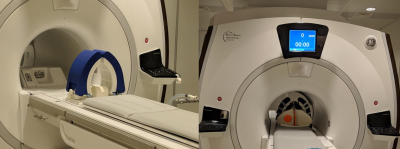 |
165 | MR thermometry guided RF hyperthermia in the head and neck region – does the new MRcollar affect the imaging?
Kemal Sumser, Tomas Drizdal, Juan Hernandez-Tamames, Gerard van Rhoon, Gennaro Bellizzi, Margarethus Paulides
Clinical studies established that adjuvant effect of mild hyperthermia can be improved by increasing thermal dose, which can be improved by online 3D dosimetry. To take advantage of MR thermometry, we developed an MR compatible head and neck RF hyperthermia applicator prototype for the head and neck region: the MRcollar. To establish the impact of the MRcollar on image quality, we imaged B1+ map and calculated the Signal-to-Noise Ratio when the body coil was used.
|
|
1599. 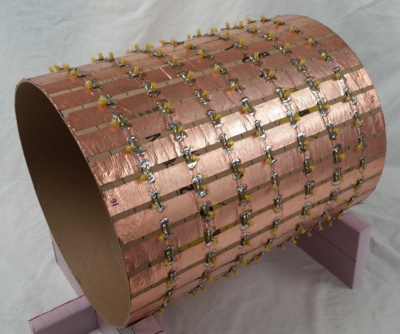 |
166 | A Frequency Selective RF Shield for MR Guided Thermal Therapies at 3T
Rock Hadley, Dylan Palomino, Robb Merrill, Dennis Parker, Charles Anderson
A proof of concept, a passive frequency selective RF shield was designed and constructed to block a single frequency (13.56 MHz) from passing through the shield. S21 and phantom SNR measurements demonstrate near transparency to the 123 MHz imaging frequency.
|
|
1600. 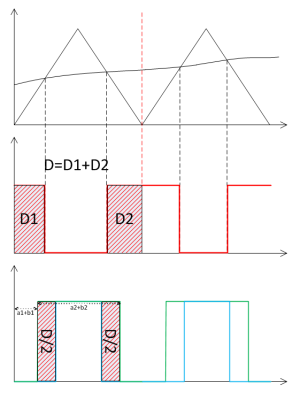 |
167 | High Resolution PWM Generation for High Frequency Switching Gradient Amplifier Control
Volkan Acikel, Aylin Dogan, Filiz Filci, Gokhan Cansiz, Ergin Atalar
Recently gradient array systems draw attention of researchers with their capabilities. However, it is crucial to drive all array elements as desired to be able to spoil all the advantages of the gradient array. In terms of adjusting the timing of the gradient pulses, generating pulse width modulation (PWM) signals from one source, i.e. a single FPGA, for all array amplifiers would be a good solution. However, required number of bits to generate PWM signal would be limited to clock frequency. In this abstract, required digital resolution to generate PWM signals is analyzed and a method to generate PWM signals with resolution less than using I/O delay (IODELAY) elements of virtex7 family FPGA is presented.
|
|
1601. 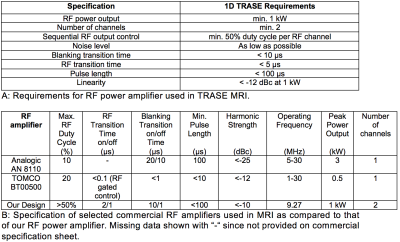 |
168 | A High Duty Cycle, Multi-channel, RF Power Amplifier for High Resolution TRASE MRI
Aaron Purchase, Tadeus Palasz, Hongwei Sun, Jonathan Sharp, Boguslaw Tomanek
A radiofrequency (RF) power amplifier is an essential component of any MRI system. Unfortunately, no commercial amplifier exists to fulfill the needs of the transmit array spatial encoding (TRASE) technique, requiring minimum 50% duty cycle, high output power 1 kW and independently controlled multi-channel capability. Hence a home-made dual channel RF power amplifier dedicated for TRASE at 0.22 T (9.27 MHz) was made using commercially available components. High spatial resolution one-dimensional TRASE was obtained with the power amplifier to demonstrate its capability. The results were compared with the commercial amplifiers, Analogic AN8110 and TOMCO BT00500, exceeding performance considering electronic noise and duty cycle.
|
|
1602. 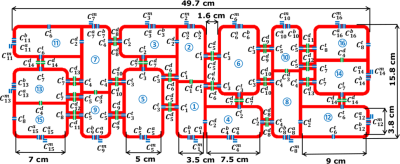 |
169 | A Novel Asymmetric 16-Element pTx Transceiver Coil Array: Towards Denser Elements for Improved RF-Shimming and G-Factor for Parallel Cardiac MRI in Pigs at 7T
Ibrahim Elabyad, M. Terekhov, M. Stefanescu, D. Lohr, M. Fischer, L. Schreiber
A novel 8Tx/16Rx coil array was designed, simulated, and tested in phantom and for cardiac magnetic resonance imaging (cMRI) ex-vivo pigs at 7T. The 16-elements of the array were distributed on a half-elliptical shape housing. Combined signal-to-noise ratio (SNR) maps and FA-maps were acquired using the developed coil before and after RF-shimming. The novel cardiac array supports parallel imaging with acceleration factors of up to R=4 without a significant degradation in the image quality. High-resolution ex-vivo cardiac images were acquired with 0.3mm x 0.3mm in plane resolution. The dedicated coil enhances the SNR within the heart by about six-times compared to a commercial human cardiac coil array.
|
|
1603. 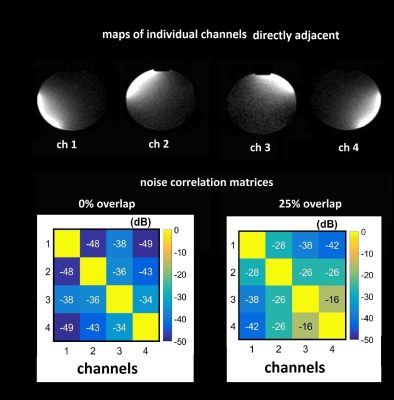 |
170 | Highly decoupled shielded loop coils as receive array elements for 7T MRI
Irena Zivkovic, Thomas Ruytenberg, Andrew Webb
We propose a shielded loop coil design for operation as a receive array element at 7T. The proposed coil geometry provides high decoupling between adjacent and non-adjacent loop elements without overlapping or preamplifier decoupling. A four-coil receive array was constructed for high resolution imaging of the knee at 7T. The coil coupling between the elements for in-vivo measurements was lower than -26 dB. Images with an isotropic resolution of 0.7 x 0.7 x 0.7 mm were acquired in five minutes. |
|
1604. 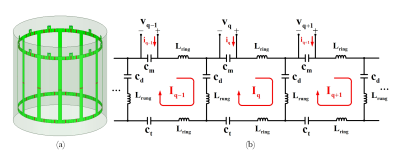 |
171 | Optimization of the degenerate birdcage transmit array coil for minimum coupling
Ehsan Kazemivalipour, Alireza Sadeghi-Tarakameh, Ergin Atalar
This abstract introduced a methodology to minimize the magnetic coupling between non-adjacent channels in a degenerate birdcage transmit array coil (DBC) by optimizing some of its physical parameters. The method is based on minimization of the mutual-inductances normalized by the self-inductances. Optimum radius, length in the z-direction, the width of end-rings, and the width of rungs are found for a 3T shielded twelve-channel head DBC with capacitive decoupled loops. Finite element based simulation results confirmed the validity of the results.
|
|
1605. 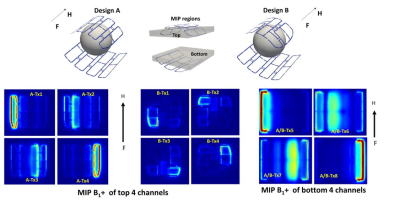 |
172 | Optimization of Phase Presets of Multi-Channel Transceiver Arrays for 7T Cardiac MRI
Maxim Terekhov, Ibrahim A. Elabyad, Maria R. Stefanescu, David Lohr, Laura Schreiber
Multiple-element transmit (mTx) phased array technology provides significant improvement of the B1+-field homogeneity in ultra-high field (B0≥7T) cardiac MRI (cMRI). We propose time efficient semi-combinatorial approach of finding optimal Tx-elements phases presets. The proposed technique allows for searching the transmitter phases providing absolute optimum for ? targeted B1+-field cost functions using high redundancy of optimal phase vector space. The technique was tested for pre-phasing of the in-house-built mTX-arrays in pigs at 7T cMRI. Improvement of the B1+-field homogeneity of >100% and SNR gain >50% was achieved using 10% of the computation time needed when compared with brute-force optimization.
|
|
1606  |
173 | The double-tuned floating cable trap: design and first results Video Permission Withheld
Martin Vít, Jürgen Sieg, Michael Pichler, Sigrun Goluch-Roat, Daniel Jirák, Elmar Laistler
We present a new design for a double-resonant floating cable trap that consists of two nested floating traps suppressing common mode currents at two frequencies simultaneously. An implementation for 1H and 31P at 7 Tesla is presented and its properties are investigated on the bench.
|
|
1607. 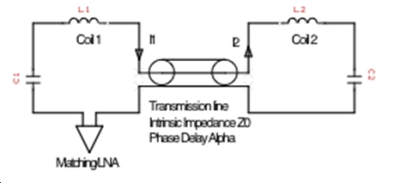 |
174 | A “Less-for-More” Concept in Array Coil Design
Tsinghua Zheng, Xiaoyu Yang, Haoqing Zhu, Yong Wu
We present a novel “Less-for-More” concept for array coil by joining different coils as one RF channel with transmission lines. This concept not only simplifies the coil design but also achieves optimum isolation among all channels by overlapping. A 4-ch 8-loop knee coil at 1.5T was constructed to demonstrate this concept. The test result shows similar signal-to-noise ratio (SNR) at the center to a commercial 1.5T 15-channel Tx/Rx knee coil’s. Furthermore, additional acceleration at g factor 2 in SI direction is also achieved with a 4-ch only coil besides axial accelerations.
|
|
1608. 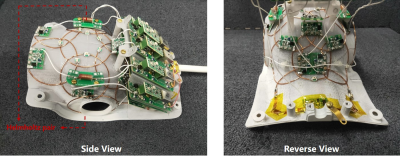 |
175 | Design of a 12-channel rhesus head coil array for functional MRI at 3 T Presentation Not Submitted
Zidong Wei, Qiaoyan Chen , Hai Lu, Xiangming Hou, Qiang He, Xiaoliang Zhang, Xin Liu, Hairong Zheng, Ye Li
In this work, a 12-channel rhesus head coil array for functional magnetic resonance imaging (fMRI) was designed, constructed and evaluated by imaging experiments in phantom studies and in-vivo studies. Compared to a commercially available 12-channel knee coil, the proposed 12-channel rhesus head coil provides improved performance not only in SNR and parallel imaging capability, but also in temporal SNR (tSNR) in resting-state fMRI studies.
|
 Back to Program-at-a-Glance |
Back to Program-at-a-Glance |  Back to Top
Back to Top